- Travel recommendations
- The taste of travel
- Tips & tricks
- Travel experiences


Everything you need to know about different flight classes

When it comes to booking your next plane ticket, one of the first things you’ll need to decide is which of the flight classes to choose. That decision will be based on multiple factors: What’s your budget? How long is the flight? Do you have any points or airmiles you can use?
The list goes on. But whatever the reasons, it’s important to make sure you understand all the key differences between the various airline cabin classes, as well as the fare classes and what they mean.
In this post
- What are airline cabin classes?
- What are the different flight classes?
- What are fare classes and what do they mean?
- Tips on how to choose the best class and fare
1. What are airline cabin classes?
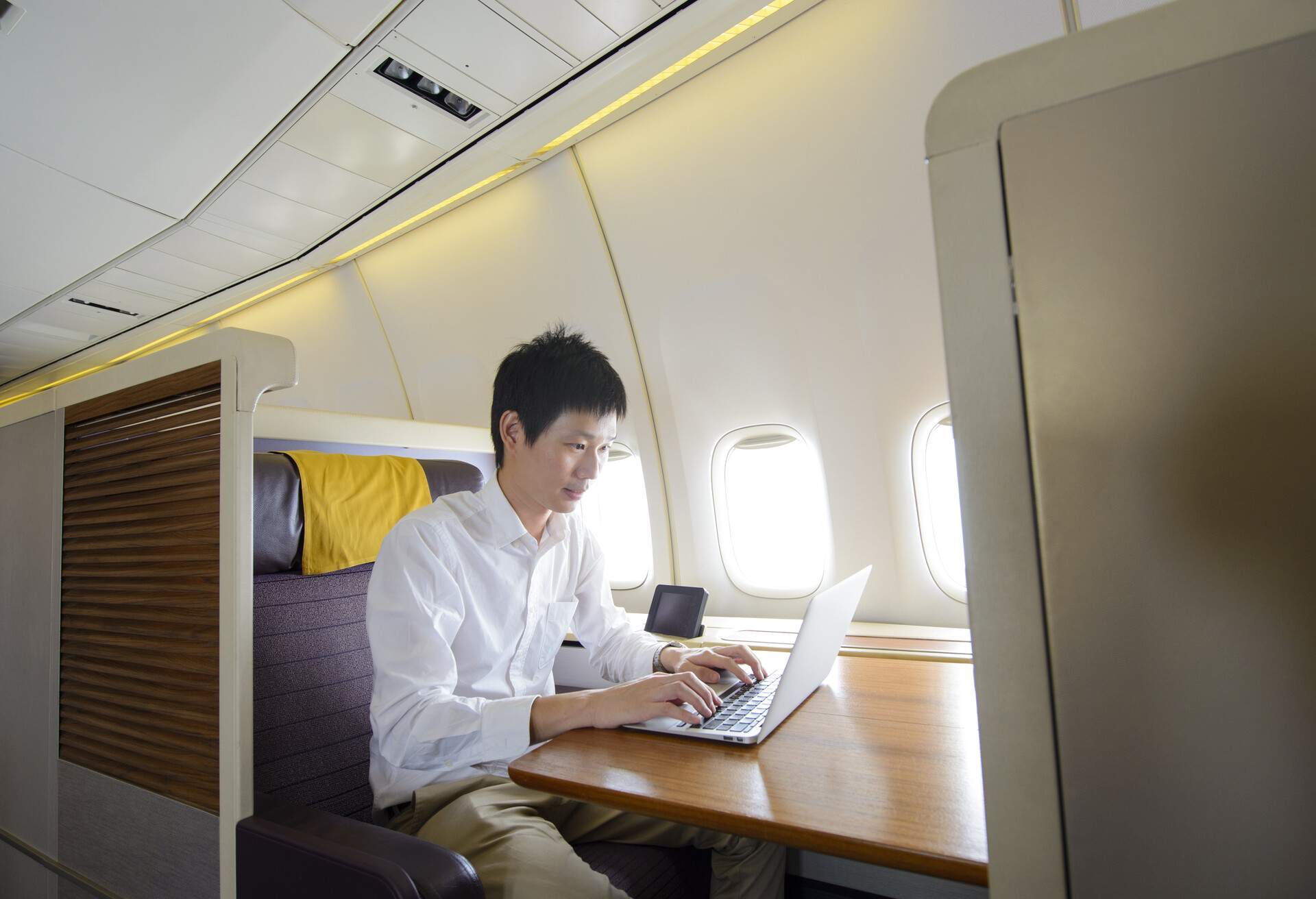
Air travel has changed a lot since the first, very basic commercial flight took to the skies in 1914. Now there’s a plethora of choices for customers, with most airlines offering four main cabin classes: Economy, Premium Economy, Business and First Class.
The main differences between these classes tend to be the cost of the flight and the extra perks and amenities you get on board – though it’s worth noting that all airlines offer slightly different options within their various classes.
Depending on the size of the airline, there may only be one single class available – Coach. Even then, an Economy seat on one carrier can differ hugely from a seat in Coach on another airline. If you’re not sure how many cabin classes your airline offers, it’s worth checking before booking.
2. What are the different flight classes?
While most airlines now offer the four main cabin classes , not all of them do, so it’s always worth checking in advance. And while certain airlines may have fleets that feature the same airplane models, many choose to design their interiors differently, so don’t just assume they’ll all be the same.
Look at the seating map for both the airline and airplane type you’re flying – doing your homework really pays off when it comes to picking the best class.
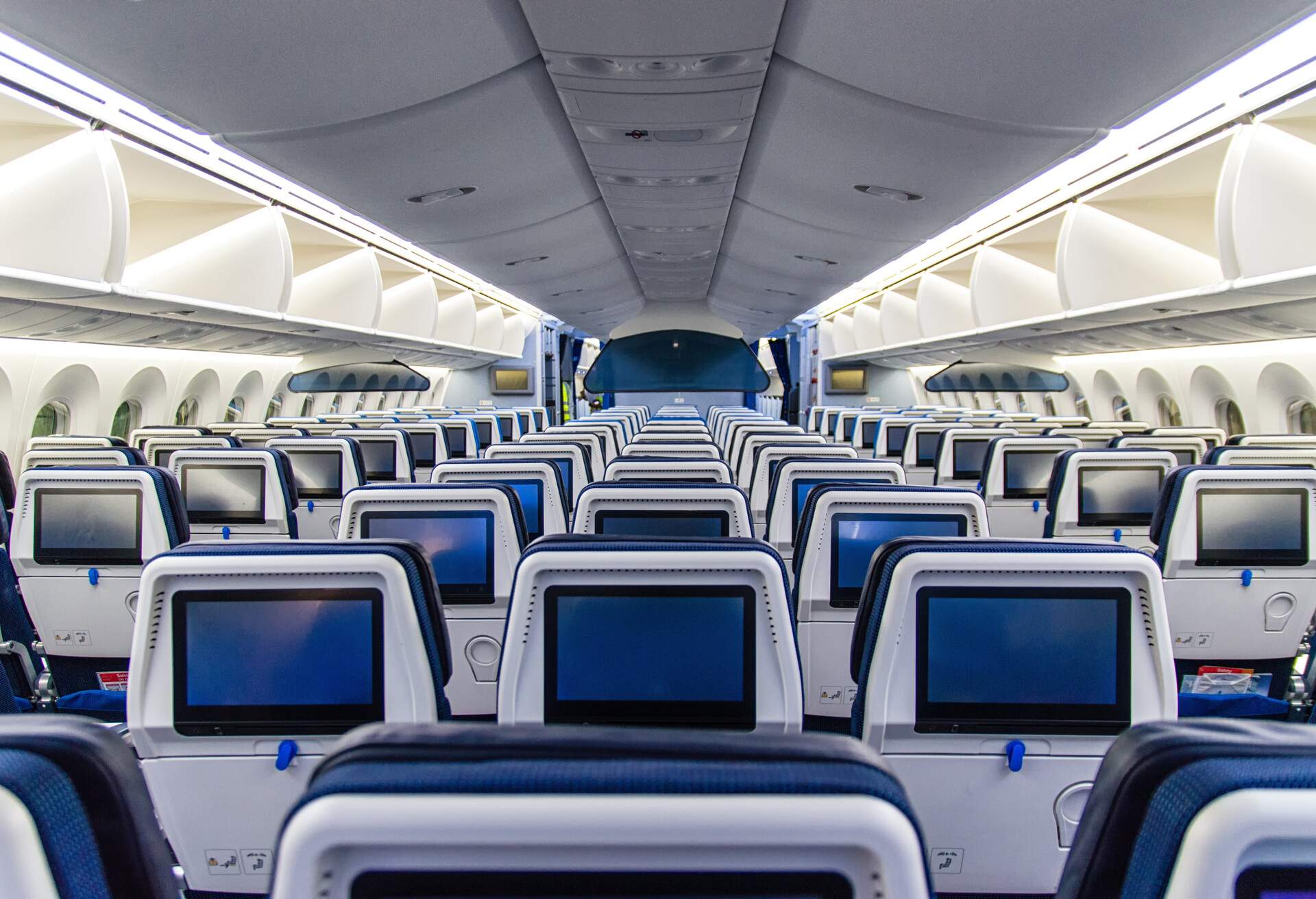
Economy seats are the no-frills option, great for travelers on a budget or those who make regular, short-haul flights and aren’t looking for luxury perks. Also known as coach, standard, or main cabin seats , this is the most affordable flight class and as basic as it comes on an airplane these days. The seats in Economy are narrower than in other classes, and you’ll also notice there’s much less legroom than in other classes. What’s included in an Economy ticket varies from airline to airline – on some flights, it doesn’t come with any extras, and things like in-flight food, Wi-Fi and luggage allowances need to be purchased separately. Other carriers might throw in complimentary snacks, drinks, and in-flight entertainment.
Premium Economy
Premium Economy offers a slight upgrade on standard Economy seats without ramping up the ticket price too much, making it a great option for frequent travelers looking for a slightly more comfortable option. The main perks in this class include wider seats and more legroom , though at a much lower price than Business or First Class. Premium Economy may be separated from other seats by a partition and often offers seats in a more desirable part of the plane (such as near the front), but they’ll usually be listed under the main cabin seats.
On domestic flights , the ‘Premium’ element usually just refers to the fact that they’re the better seats on an aircraft , but on international flights, Premium Economy may offer perks like better food, a larger baggage allowance and free amenity kits.
Those looking for a more luxurious option than Economy but who don’t want to stump up for first-class go for Business, which sits somewhere between the two. Business is definitely a big step up from Economy, offering much more comfortable seats that are wider and can either recline or lie flat, full, or multi-course meals (some of which are served on good China rather than disposable trays) and personal bar service . Naturally, offerings vary depending on different airlines , so it’s worth checking what each one offers before booking.
Lounge access is another great perk that comes along with buying a business-class ticket, particularly if you’re making a stopover on a long-haul journey. For the best deals, check out KAYAK’s handy guide on buying cheap business-class tickets .
First Class
It doesn’t get any better than First Class , which is the crème de la crème of flight classes. This is the most luxurious option available, and you can expect the price of your ticket to reflect that. Passengers in first class get to feel the benefits before they even get on board, skipping the long Economy check-in line and boarding first . The offerings vary vastly depending on the airline , but typically you can expect seats that flatten fully, plenty of personal attention from the flight attendants, special privacy features like your own door and a full meal service with the sort of food you might get in a nice restaurant. Some airlines, such as Emirates, really pull out all the stops, offering passengers their own suite with a double bed and a bathroom with a shower.
3. What are fare classes and what do they mean?
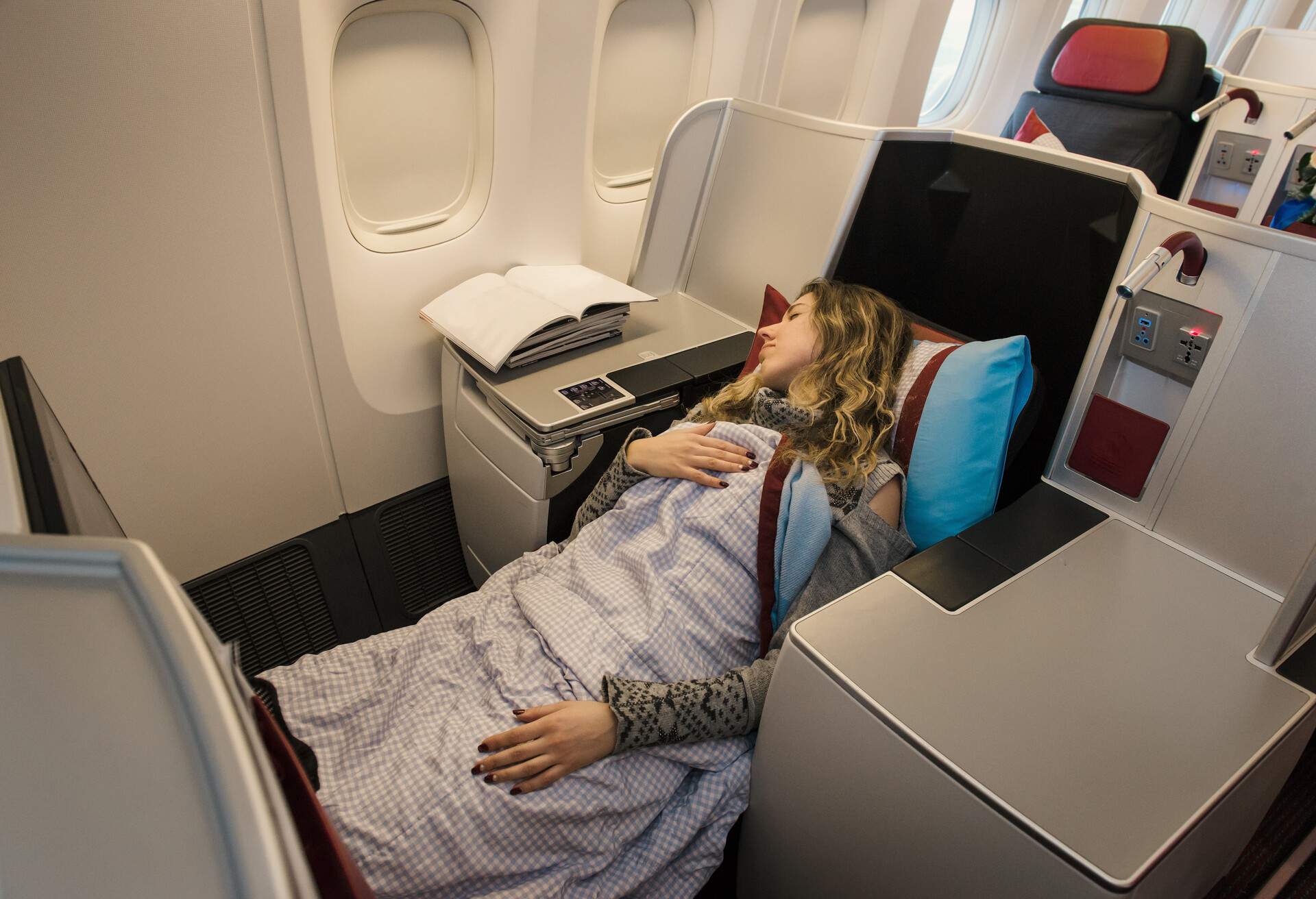
The various fare classes airlines use divide every seat on a plane into different categories, each of which comes with its own price and its own set of rules. These fare classes are identified by one-letter codes , which you’ve probably spotted on your boarding pass before without realizing what they mean (I know I have). While fare codes vary from airline to airline, there are a few that are generally the same, such as the first letter in the fare basis code that represents the fare classes:
- Y: Full-fare Economy-Class ticket
- W: Full-fare Premium Economy Class ticket
- J: Full-fare Business-Class ticket
- F: Full-fare First-Class ticket
The fare basis code (series of 1-8 alphanumeric characters) holds lots of key information, such as the price of your ticket, how many air miles you’ll earn for that flight, and the level of flexibility you have to make any changes. Airlines use fare classes to help control their inventory and determine how many tickets can be sold at a particular price.
4. Tips on how to choose the best class and fare
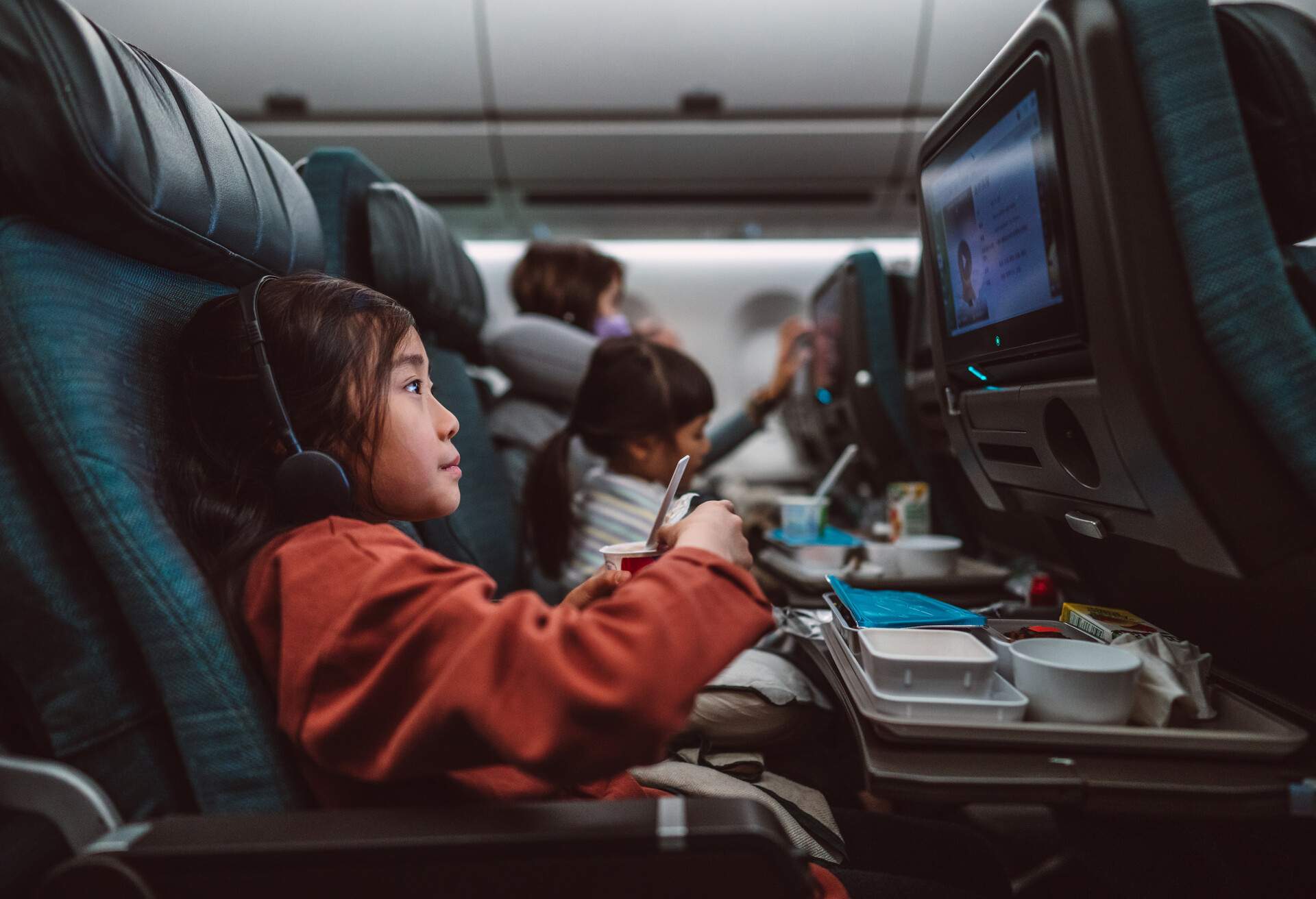
With so many factors to take into consideration, it’s important to make sure you know exactly what you’re looking for when booking a flight.
Once you’ve determined things like budget and whether you want to put airmiles towards a booking, you can start searching for the best deals in different flight classes and fare classes .
Use KAYAK’s Flight Search tool to track down the best deals. Here are a few tips and tricks to make sure you’re getting the most out of your next plane booking:
- Do your homework and shop around to make sure you’re getting the best deal on airline cabin classes.
- Fare classes vary by airline, so consult them directly to ensure you understand what each letter means before booking a flight with them.
- It’s important to know what fare class you’ve booked, as that will help you fully understand how it will affect your flight. For example, certain fare classes might prevent you from upgrading tickets or could earn you more points than others. Knowledge is power when it comes to making the most of airline deals and restrictions.
- Generally, the cheaper the fare class, the more restrictions will be associated with that fare.
How this guide was created
I’ve been a travel journalist for 15 years and during that time have hopped on and off more planes than I can count, experiencing everything from cramped long-haul stints in coach to ultra-luxurious trips in first-class and all-expenses-paid private jets. This guide pulls together all the knowledge I’ve gathered during those excursions, as well as extensive research into different airline cabin policies and fare classes.
Some of our favorite flight routes
- Flights to New York
- Flights to Los Angeles
- Flights to Chicago
- Flights to San Francisco
- Flights to Miami
About the author
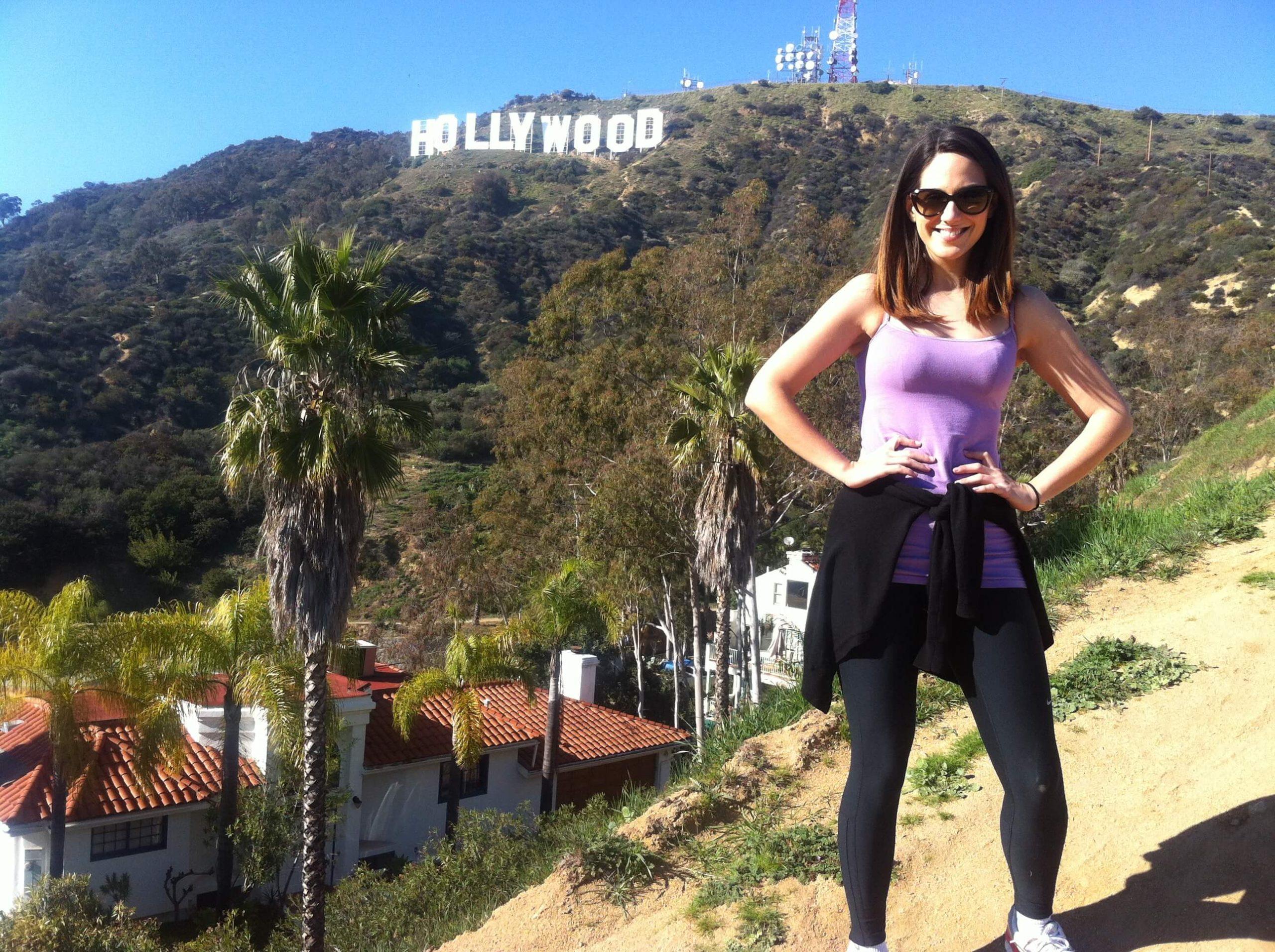
Explore more articles
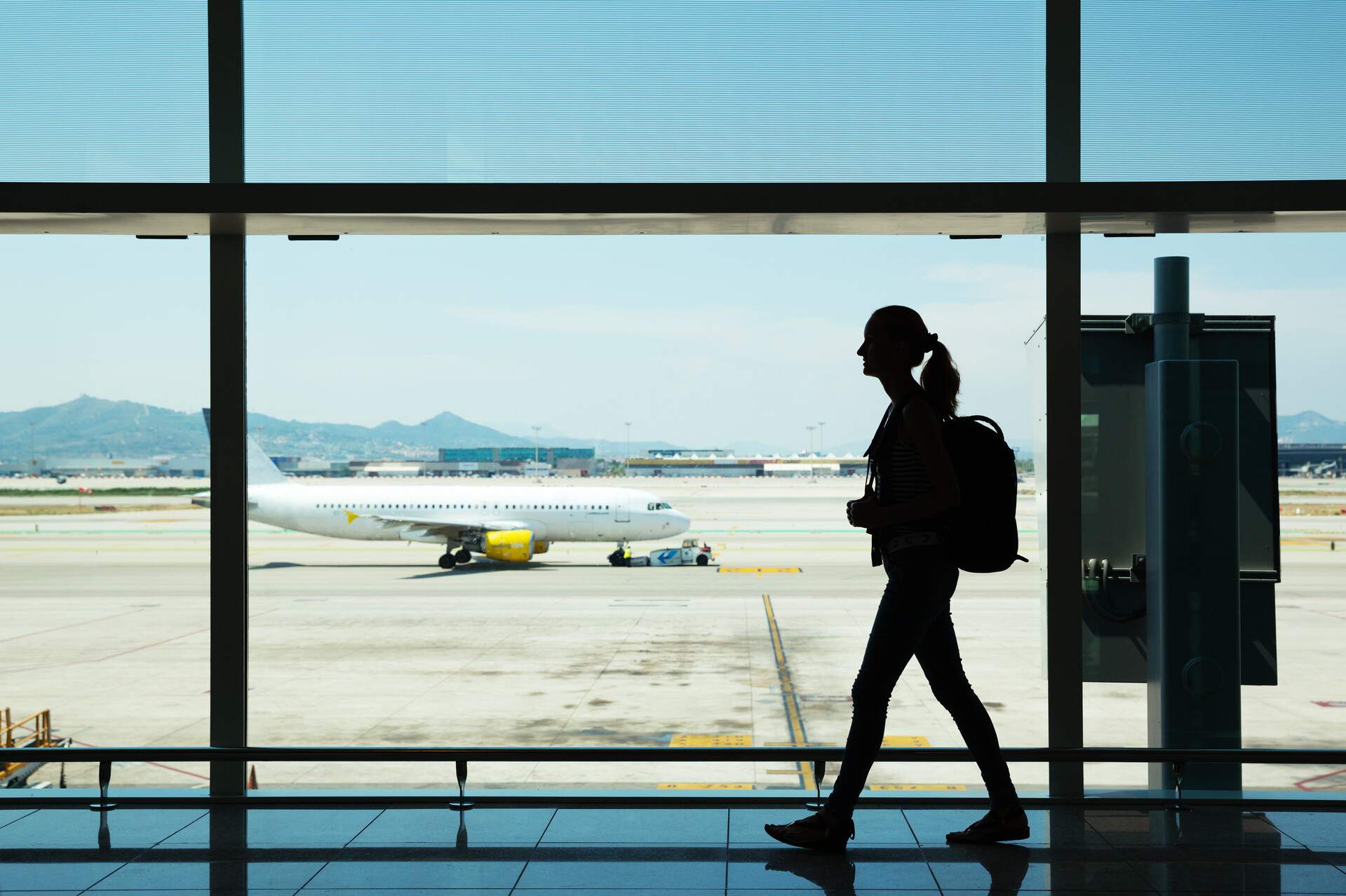
California consumers have the right to opt out of the sale * of their personal information. For more information on how we securely process personal information, please see our Privacy Policy .
Do not sell my info ON
* The definition of "sale" under the California Consumer Privacy Act is applicable only to California consumers.
- Travel Recommendations
- Travel in the US
- The Taste of Travel
- Tips & Tricks
- Travel Experiences

What are the differences between airline classes?

How to understand and use different airline classes
Since the first commercial flight in 1914, the airline industry has achieved many milestones , including introducing innovative amenities to entice travelers to fly the friendly skies. Today’s flight experience is, of course, vastly different from the inaugural commercial flight in 1914. One of the most notable differences is how much we pay for our journey and what’s included in the price. Flight prices today are really about getting from point A to point B. Another development has been the introduction of multiple classes of service and the variety of pricing schemes within each fare class, allowing you to only pay for the extras if you choose.
We’ve purchased our fair share of seats across all air carriers, and it’s clear not all seats and classes are equal. Here are answers to frequently asked questions about North American airline classes and what you can expect from each class. Read on for help choosing a seat, and then find that perfect flight on Cheapflights.com .
What are airline cabin classes? What airline cabin classes are there? What can you expect in Premium Economy on North American flights? What are fare classes? What does each letter of the fare basis code mean? How do fare class letters and miles work? How can you use fare classes when finding flights?
Search for flights
1. What are airline cabin classes?
There are 4 cabin classes offered on most airlines: economy, premium economy, business, and first class.
“In the early days, all seats were first class,” said Seth Kaplan, managing partner of “ Airline Weekly ,” a subscriber-supported publication about the airline business.
“In the 1950s, airlines including Delta Air Lines , began experimenting with coach flights at off-peak hours – in other words, not first class and coach cabins separated by a curtain, but entirely separate flights. Later they begin offering 2 cabins on the same flight, as we see today,” said Kaplan.
The number of seats increased after deregulation kicked in, calling for more seats to make more profits per flying mile, said Stephen Carbone, who has worked for the National Transportation Safety Board (NTSB) as well as the Federal Aviation Administration (FAA).
“Seats were wider because the airlines were subsidized, so they could afford flying fewer people to more obscure locations. This was changed with the introduction of the hub-and-spoke routing system,” said Carbone. “Destinations were now decided by passenger numbers, which brought about the concept of how many seats can we legally and safely fit.”
Depending on the airline, some seats have shrunk over time while others have remained the same across all classes of service. See our guide to how to pick the best airline seat and which airline has the best legroom for secure the best seat.
2. What airline cabin classes are there?
While there are 4 airline cabin classes, some airlines only often one — coach. But a seat in coach class on 1 carrier can be vastly different from an economy seat on another airline. Many airlines have the same airplane models in their fleets, but they configure the interiors differently, so it’s important to look at the seating map not only for the airplane type but also the airline you are flying. Using another airline’s map may not be accurate. If your airline doesn’t provide airplane seating charts, call and speak with an agent, who should be able to provide guidance.
Here is what you can expect in each class:
Economy: Whether you call it coach, standard, main cabin, or “cattle class,” economy is the most basic class. The seats here are the narrowest, ranging from 16 inches to just over 19 inches wide and the seat pitch, the distance from one seat to the seat in front or behind it – what travelers often refer to as “legroom” – ranges from 30 inches to 34 inches. These days, economy offers little more than a seat that will get you from point A to point B. Some airlines like jetBlue and Hawaiian Airlines offer free snacks and beverages and in-flight entertainment systems. Delta Air Lines offers 3 classes of service: Delta One (180-degree flat-bed seat featuring Westin Heavenly bedding and a dedicated flight attendant on cross-country U.S. flights and long-haul international flights), first class (up to 8 inches of additional legroom, up to 5.4 inch seat recline, and a wider seat-back screen), and main cabin. Main cabin is further divided into 3 “experiences” based on seat size and location: Delta Comfort+, Main Cabin, and Basic Economy. Some low-cost carriers like Allegiant Air , Frontier Airlines and Spirit Airlines only offer coach class.
Premium economy: Virgin Atlantic was actually the first airline to incorporate the concept of premium economy back in 1992. Since then, dozens of airlines have picked up the concept. Once only found on international flights, premium economy is widely available on flights within North America. The slightly comfier premium economy offers wider seats and more legroom at a comfier price than business or first class on most airlines. Some airlines categorize economy and premium economy under main cabin. Typically physically partitioned on international and some long-haul flights, the “premium” in premium economy is the added space and sometimes location of seats in more desirable locations, like the front of the aircraft. On international flights, premium economy may not only be physically separate from economy class, but it may also offer additional perks like complimentary or better food, a greater baggage allowance and amenity kits. Premium economy often refers to the “better” seats on an aircraft on domestic flights.
3. What can you expect in premium economy on North American flights?
- Alaskan Airlines: Alaskan Airlines’ passengers can book Preferred Plus Seats , which are located in row 6 and in the exit rows on select flights. The seats offer the same 3 inches of recline as the standard seats do (except in row 16, which doesn’t recline) but more legroom: a 36- to 40-inch seat pitch.
- Allegiant Air: Allegiant Air has all-coach configurations on its planes, but select flights offer Legroom+ seating, which offers a larger seat pitch of up to 34 inches, and Giant Seats , which have wider seats, comfy headrests and more legroom. There are 6 Giant Seats per plane, in the front row and mid-cabin emergency exit row, on planes that fly to and from Hawaii and several Western U.S. cities.
- American Airlines: American Airlines’ Main Cabin Extra offers seats with more legroom at the front of the plane starting at $20.
- Delta Air Lines: Delta Airlines’ Delta Comfort+ seat offers up to 4 extra inches of legroom, dedicated overhead bin space, and priority boarding.
- Frontier Airlines: Travelers who opt to upgrade to Frontier Airlines’ Stretch seating get to enjoy in-flight service first, get off the plane first, and sit in seats that are laptop friendly and offer more legroom: 33 inches to be exact on all aircraft types.
- Hawaiian Airlines: Hawaiian Airlines’ Extra Comfort seating, available only on the Airbus A330, features a 36-inch seat pitch; priority boarding at the gate, complimentary on-demand in-seat entertainment and a personal power outlet.
- jetBlue: Options for more legroom on jetBlue include Even More Space seats, which offer up to 38 inches of legroom. There are 7 rows of Even More Space seats on the Airbus A320 and both Airbus A321 configurations and 4 rows on the Embraer 190 (rows 1, 12, 13 and 14), offering passengers more legroom, early boarding and more.
- Porter Airlines: On Porter Airlines , travelers can upgrade to a premium seat , which offers more legroom, at the time of booking for $20 (Flexible and Freedom fares) and $40 (Firm fares). Premium seats are located at the front of the plane (Row 1, Seats A and B; and Row 2, Seats A, B, C and D).
- Southwest Airlines: There is no assigned seating on Southwest Airlines and all seats are coach class. Southwest’s sole upgrade option is Business Select , which guarantees, among a variety of perks, priority A1-15 boarding, allowing passengers who upgrade to pick the seats they want and have a place to stash their carry-on luggage.
- Spirit Airlines: Spirit Airlines offers their BIG FRONT SEAT for those who prefer more space. BIG FRONT SEAT options are located in the front of the plane, have a 36 inch pitch and are 25 inches width, with a full 6 inches of additional legroom compared to the airline’s standard Deluxe Leather seats. The BIG FRONT SEAT option can be purchased for a fee during or after booking, based on availability.
- United Airlines: United Airlines ’ Economy Plus seating offer more legroom and wider seats and is available as a one-time purchase or as an annual subscription.
- Virgin America: Virgin America ’s Main Cabin Select offers roomier seats with a 38-inch pitch (6 extra inches of legroom).
- WestJet: WestJet ’s premium economy fare a Plus seat that affords travelers a variety of amenities, including more legroom. Located in the first 3 rows of the Boeing 737 aircraft, Plus seats have a 36 inch seat pitch. Plus seats are also located in the first four rows of the Boeing 767 aircraft and have a 38 inch seat pitch.
Business: The happy medium between coach class and first class is business class. Pioneered by airlines like Pan Am and Qantas , Business class was born after deregulation of airlines when international first-class fares skyrocketed, discounts in economy were common, and full-fare coach travelers were not happy. Business class is a completely different class from economy, and airlines have increased the quality in this category so much that some have replaced first class with business class or, as was the case with now-defunct Continental Airlines, combined the privileges of business class with the luxuries of first class into what the airline called BusinessFirst when it launched in the early 90s. On some airlines like Delta Air Lines, international flights may offer business class service in lieu of first class. The experience ranges from a wider seat that reclines back but doesn’t lie flat, full meal service, in-flight entertainment and an amenity kit on American Airlines, to a seat that converts to a full lie-flat seat, personal minibar, multi-course meals served on fine china and a full bar area complete with bartender and canapés on Emirates .
First Class: Passengers can’t get upgraded any further than first class, which is a luxurious experience that varies depending on the airline. The experience of first class can range from jetBlue’s Mint , which features a 6-foot, 8-inch lie-flat seat with adjustable firmness and a massage feature, a door for privacy, in-flight entertainment and full meal service to Etihad’s The Residence , a 3-room suite with living room, bedroom with a double bed and private bathroom with shower.
4. What are fare classes?
The service classes of economy, premium economy, business, and first class are further divided into fare classes, which appear as a letter on your ticket. Each seat on an airplane is put in a fare class, which each come with their own set of rules and price. What might look like a random letter on your ticket is actually a valuable piece of information that shouldn’t be overlooked.
A ticket’s fare class (also called a booking class or fare bucket) is represented with one of the 26 letters of the alphabet. Originally, booking codes were standardized by the International Air Transport Association , a trade association for airlines, but booking codes are now determined by each airline. Most airlines have a different fare class for each letter of the alphabet, and this varies by airline: F is first class, C and J are typically business class, and Y is usually economy, regardless of the airline. The assignment of letters to each fare class isn’t arbitrary. Take C for business class, which derives from Pan Am , which was one of the first airlines to introduce a new class of service for business and full-fare economy passengers called “Clipper Class.”
The fare class letter denotes information like how much your ticket costs, how many airline miles you’ll accrue for the flight, and the amount of flexibility you have to change your reservation. Airlines, reservation systems and travel agents use fare classes to keep track of tickets sold and fare class availability. This one letter is often the difference between you paying hundreds of dollars more or less for your ticket than the person next to you.
Airlines want to get the most they can for each seat while also aiming for a full flight, so ticket prices fall within particular fare classes or buckets to help control inventory and how many tickets can be sold at a particular price. Each fare class has its own price, fare rules, including how much mileage is earned for the airline’s loyalty program and if the ticket can be changed or not. There are also “hidden” fare classes for frequent flyer awards and elite upgrades that are not normally shown in travel searches.
To control inventory while aiming to get as many passengers to pay as much as possible, airlines divide the seats into buckets. Airlines use an algorithm that takes into account factors like the number of seats on a flight, departure and destination airports, the time of day, the time of year, and the expected breakdown of leisure and business passengers to determine how many seats get assigned to each bucket for a particular flight. It’s hard to gauge how many seats are allotted to each bucket, but once the seats within a bucket are sold for a flight, the bucket isn’t replenished. To control inventory and maximize profit, airlines don’t release these numbers. Only travel agents and airline staff or travelers who subscribe to services like Expert Flyer can see how many seats remain in each class.
Fare classes vary by airline, so it’s important to consult the airline directly for confirmation about what each letter means. The letters within each fare class have a hierarchy. When reading an airline’s fare class chart, read from top to bottom and left to right. For example, on American Airlines, F and J are both full-fare first class/business class, but F is higher than J. Hierarchy becomes meaningful when you’re looking to upgrade or standby for a flight.
The fare class code is just the beginning. Each ticket also has a fare basis code, an alpha or alphanumeric code that describes the fare you bought, making it easy for airline staff and travel agents to quickly access the fare rules for a ticket. Each airline sets their own fare class codes that range from 3-8 characters. Almost always, the fare basis code begins with a letter that denotes the class of service. What follows after may refer to the season, how many days in advance the ticket needed to be purchased, minimum and maximum stay requirements, whether a fare is valid on a weekday or restricted to weekends only, or whether the fare is one-way or round-trip. additional fare rules like non-refundable or to signify the fare is a child fare or infant fare. If you have an itinerary made up of multiple fare codes, you may be restricted by the limitations of the most restrictive portion, so check with the airline to ensure you understand the fare rules and restrictions.
When searching for airline tickets by classes, you only need to concentrate on the first letter.
5. What does each letter of the fare basis code mean?
Flights within Canada:
- J, C, D = Business Class (flexible) | Premium Rouge
- Z, P = Business Class (flexible) | Premium Rouge
- O = Premium Economy
- E, N = Premium Economy (lowest)
- Y, B = Latitude
- M, U, H, Q, V, W, G = Flex
- S, T, L, A, K, F = Tango
Flights between Canada and the U.S.:
Flights between Canada and Sun Destinations (Caribbean, Mexico, and Central America)
- J = Business Class (flexible) | Premium Rouge
- C, D, Z, P = Business Class (lowest) | Premium Rouge
- M, U, H, Q, V = Flex
- W, G, S, T, L, F, A, K = Tango
Flights between Canada and International Destinations (Europe, Israel, Asia, Australia, and South America)
- O = Premium Economy (flexible) | Premium Rouge
- Alaska Airlines
- F, P = First Class
- Y, S = Economy
- M, B = Discounted Economy
- H, Q, L, V, N, K, G, T, R, W = additional economy seats with the most restriction
- U = complimentary upgrades
- Z = Refundable Main Cabin awards
Allegiant Airlines
The all-coach airline offers Giant Seats and Legroom+ seats on select flights for an additional fee.
- American Airlines
- F, J = Full Fare First Class/Business Class
- A, P, D, I, R = Discount First/Business
- Y, W = Economy
- H, K, M, L, W, V, G, Q, N, S = Economy
- B – Basic Economy
- Delta Air Lines
- F = First Class
- P, A, G = Discounted First/Delta Premium Select
- J = Business
- C, D, I, Z = Business and Discounted Business
- W = Premium Economy (Available on flights operated by Air France , Virgin Atlantic, and Virgin Australia )
- W = Delta Comfort
- Y, B = Economy
- M, H, Q, K, L, U, T, X, V, E = Economy, Discounted and Deeply Discounted Economy
- R, O, S, N = Award Travel
- Hawaiian Airlines
- F, P, C, A = First Class (Inter-Island and Transpacific flights)
- J, P, C, A = Business Class (international flights)
- Y, W, X, Q, V, B, S, N, M, I, H, G, K, L = Economy (Inter-Island flights)
- Y, W, X, Q, V, B, S, N, M = Economy (Transpacific and International flights)
- I, H, G, K, L = Additional Economy seats with the most restrictions. (Transpacific and International flights)
- Porter Airlines
Tickets are classified as Firm, Flexible, and Freedom , which determines fares and rules.
- Southwest Airlines
Tickets are classified as Business Select, Anytime, Wanna Get Away, Senior Fares, and Rapid Reward Companion Pass .
- Spirit Airlines
The all-coach airline offers passengers the option to purchase a BIG FRONT SEAT for an additional fee. There are 10 on the airline’s A319 aircraft and 4 on the airline’s A320 and A321 aircraft, according to the airline’s fact sheet .
- United Airlines
- F, J = First Class
- A, D = Business First
- C = Business
- Z, P = Business Class
- M, E, U, H, Q, V, W, S, T, L, K, G = Discounted Economy
- N = Reward travel
- Virgin America
- J, C, D = First Class, which includes no change or cancellation fees, 2 free checked bags, meal service, 55-inch seat pitch, 165-degree reclining massaging chair and priority boarding.
- W = Main Cabin Select with no change or cancellation fees.
- Z, Q = No change or cancellation fees, 1 free checked bag, free food, drink and movies, 38-inch seat pitch and priority boarding.
- Y = Main Cabin with no change or cancellation fees and 1 free checked bag.
- V, B, H, E, U, M, I, L, S, N = Main Cabin with no change or cancellation fees and 1 free checked bag, 32-inch seat pitch, and seat-back entertainment.
Tickets are classified as Member Exclusive, Econo, Flex, Plus Lowest, and Plus Flexible .
6. How do fare class letters and miles work?
Frequent-flyer miles aren’t based on the number of miles flown. The fare class determines how many airline miles you will accrue for the flight. Some fare classes offer double or triple miles while other classes offer no miles. Depending on your objective, achieving status on an airline or booking the cheapest ticket possible, reviewing the mileage accrual chart for your chosen airline may be an important factor in choosing which flight to book.
The following are links to each North American airline’s mileage accrual charts for eligible published fares. These charts denote the relationship between the fare class letters and miles passengers receive who fly in these classes.
- Allegiant Air
7. How can you use fare classes when finding flights?
Most airline websites allow for searching for flights by fare class by selecting the advanced booking options. Expert Flyer allows users to search for flights by fare code. When shopping for tickets on airline websites, the fare code is displayed toward the end of the booking process, either when selecting flight options or just before submitting payment. Typically, there is a correlation between the fare class and the price of the ticket; the cheapest fares are the lowest fare classes. Tickets that have more perks and fewer restrictions have higher fare classes (and, most often, higher prices).
What fare class do you typically purchase when you fly? Share your preferences in the comments and start your next flight search on Cheapflights.com .
About the author
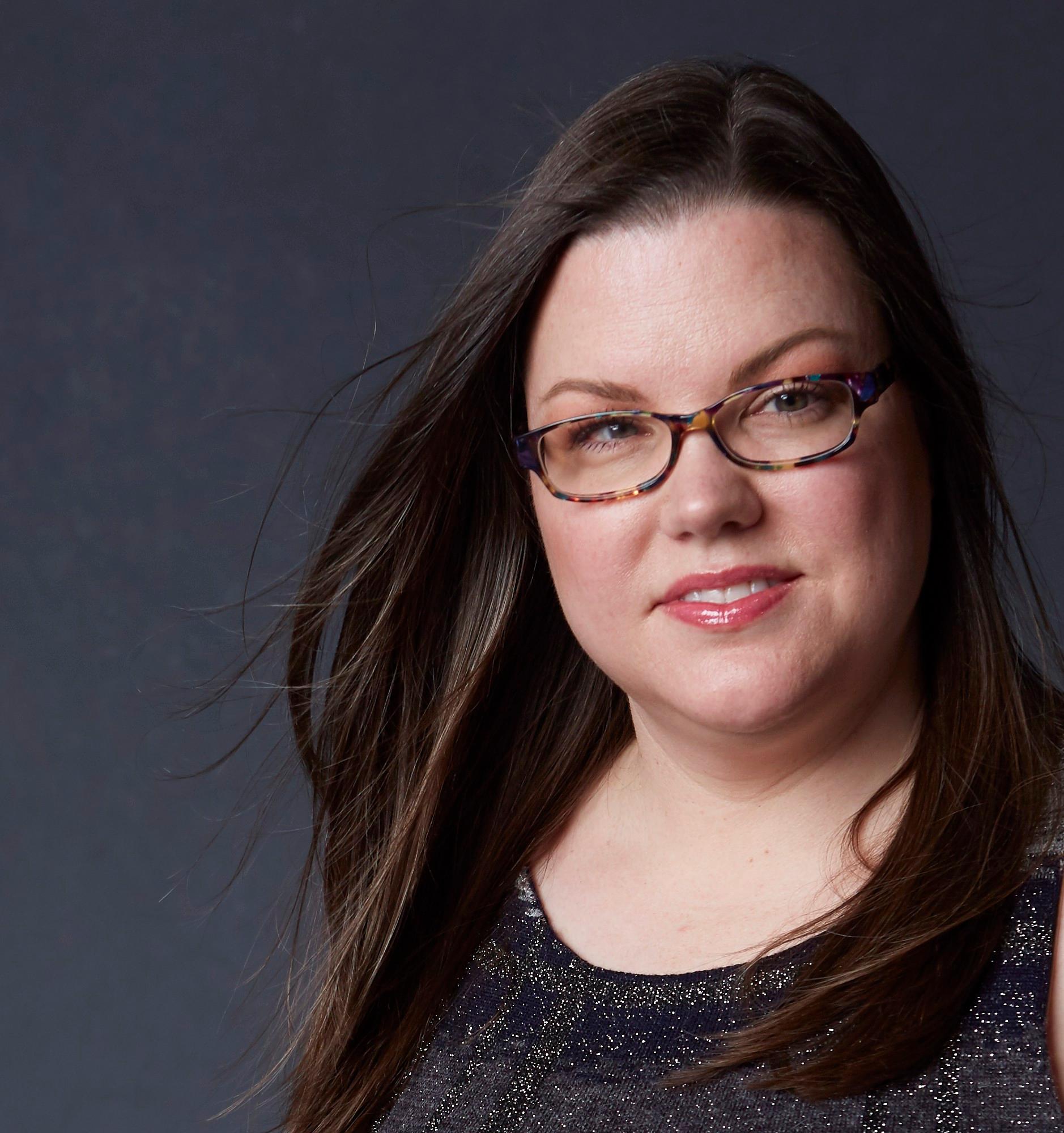
Explore more articles
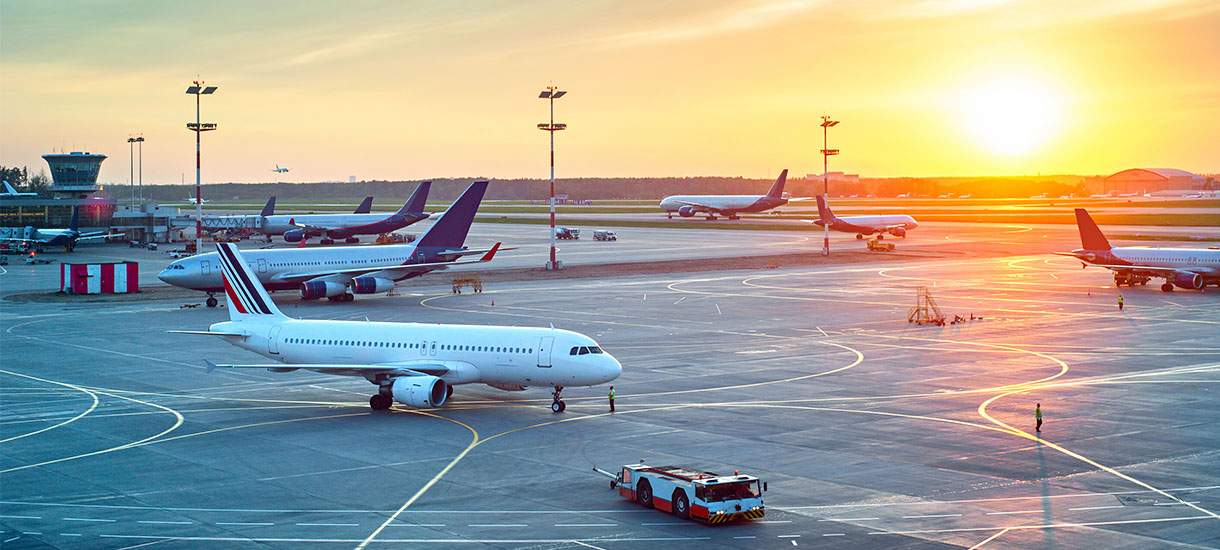
California consumers have the right to opt out of the sale * of their personal information. For more information on how we securely process personal information, please see our Privacy Policy .
Do not sell my info ON
* The definition of "sale" under the California Consumer Privacy Act is applicable only to California consumers.
What the Airfare Class of Service Letters Mean
If you've ever bought a plane ticket and noticed an odd group of letters on it, chances are those were service letters. These letters indicate the class of service for your plane ticket as well as the type of fare that was purchased. And, since the classes may vary from airline to airline, understanding what the class of service letters mean can be difficult.
Class of Service Letters
When you see a group of letters on your flight ticket or receipt, they usually refer to the class or kind of ticket you bought as well as what perks or extra costs may come with that fare. Though many of the airlines have similar class indicators, these are not universal so be sure to always double check your ticket.
- F, A and P are the letters that indicate a full fare First Class ticket.
- J and C represent full fare Business or Executive Class ticket.
- W represents premium economy ticket.
- Y is almost universally used for full fare economy tickets.
- B, H, L, M, and V are just some of the letters indicating subclasses (reduced, restricted, and/or discounted fares). These letters vary by airline and in value. On one airline B may be indicative of a more expensive ticket. On another airline, L may represent a ticket booked for a seat sale. Check the fine print to make sure you understand what specific ticket you purchased.
- X, U, and R commonly refer to a fare purchased from a consolidator. Consolidators are companies that buy tickets directly from airlines at special discount prices, and then resell them to travel agents or customers for prices much lower than published fares . These sales can be as much as 20 to 70 percent off the sticker price. Tip: For the best deals, look for consolidator tickets on international flights.
Fare classes are used by airline reservation systems and travel agents to sell seats on a plane, helping them keep track of which fare classes are still available for purchase.
Where to Find the Class of Service Letters
If you have booked a discounted fare and are interested in the subclass you are holding, check the letter immediately following the flight number on your ticket. It may also fall under the heading of Booking Class or some similar, shortened phrase. If you happen to see an E after the service letter, this is a ticket with an excursion fare, which means that there is a minimum or maximum stay attached to your destination or trip. This typically only happens if you book an itinerary through a travel agent or cruise line.
Keep in Mind
As with all flight classes, it's important to know what you are getting for the price. Economy tickets (Y service letter) usually indicate less flexibility with changing tickets as well as restrictions such as not being able to select your seat ahead of time, no free checked bags, and so on. On the other hand, unrestricted fares are some of the most expensive tickets, but they provide conveniences like full refunds and flexibility to change flight itineraries. This is especially beneficial for business travelers who may need to extend a work trip or go to multiple destinations.
What Is a Fare Class?
How to Travel the World for Free Using Miles and Points
What Are North American Airlines' Policies on Bereavement Fares?
Booking a Baby Bassinet for Your Flight
8 Air Travel Rights You Didn’t Know You Have
Budget Airline Baggage Fees
Paper vs. Electronic Plane Tickets
How to Travel from Los Angeles to Denver by Train, Bus, Car, and Plane
North American Airlines on Rules for Overweight Passengers
Why Senior Airfares Have Disappeared
5 Ways to Find the Cheapest Train Travel
Saving Money on Your Summer Vacation
Best Online Travel Agencies
How to Find Senior Discounts for Budget Travel
How to Get a Free Upgrade From an Airline
Car Seat Policies for the Top 15 North American Airlines
Simple Flying
The different classes of travel offered by delta air lines.
The US legacy carrier offers a variety of different cabins across its fleet.
- Delta Air Lines offers different classes of travel, including Basic Economy, Main Cabin, Delta Comfort+, Domestic First Class, Premium Select, and Delta One.
- Basic Economy is the cheapest fare class with fewer amenities and seat selection restrictions. Main Cabin offers advanced seat selection and other benefits.
- Delta Comfort+ provides extra legroom, priority boarding, and dedicated overhead bin space. Domestic First Class offers spacious seats and additional amenities like fine dining and expedited baggage service.
Airline cabins have greatly expanded from the days of just economy and first class. Today, carriers have several different classes and different seats depending on the aircraft and travel distance. Delta Air Lines has adopted this over the years, with three classes on international flights and two on domestic or regional flights. Here's the breakdown.
Basic economy
Basic economy is technically a fare class, not a different cabin. Booking the cheapest ticket means no checked bags, one carry-on, no cancelations, and no free seat selection until check-in. Amenities vary by distance, so expect meals and snacks on long-haul routes, but just soft drinks on domestic services.
Your seat will vary significantly depending on where you're flying, but is the same as every other economy class passenger's seat. On regional CRJ-200/700/900, expect a tighter 2-2 layout, a standard 3-3 on the mainline narrowbodies like the 737, and 2-3-2 or 3-3-3 on widebodies like the A350 or A330neo.
Across the fleet, you can expect to get 30" to 32" of pitch on all planes, from the CRJ-900s to the A350-900s. It's certainly not the most, but it's in line with the competition as well.
Delta's Main Cabin experience is a step up from basic economy, as it allows you to choose where you sit in advance. You'll also get benefits like earlier boarding, free date changes, and advance seat assignments (except Preferred and Comfort+ seats).
For a small fee, passengers can also choose a Preferred Seat. These are typically located near the front of the plane, or in emergency exit rows, which offer more legroom.
Get the latest aviation news straight to your inbox: Sign up for our newsletters today.
Delta Comfort+
Booking a Delta Comfort+ ticket is where the added extras really start to kick in . For example, this class of travel gets you priority boarding. Furthermore, once you're onboard the aircraft, you'll have a seat that reclines up to 50% further than standard Main Cabin seats and offers up to four inches more legroom. Comfort+ seats are located at the right of the front of the economy cabin on all of Delta's aircraft.
Comfort+ passengers are allocated dedicated overhead bin space to keep their belongings conveniently close. This is always a welcome relief on busy flights when such space is at a premium. Early boarding also means skipping the dreaded gate check, allowing you to take your carry-on all the way to the destination.
On long-haul international flights, in addition to a sleep kit, passengers are also given an amenity kit. This contains useful items such as eyeshades, earplugs, a toothbrush, and toothpaste.
Domestic First Class
On domestic aircraft, Delta offers two cabins: Main Cabin and First. Hard product-wise, the First cabin is laid out in a 2-2 configuration. Each seat features a leather recliner, and Delta's newest A321neos even have seat dividers and pod-style privacy guards.
You'll also benefit from accelerated check-in, security, and baggage handling. You'll have a spacious seat with up to eight inches of extra legroom, a pre-set pillow, an in-seat power port, and an entertainment screen of up to 13 inches. This is typically the best cabin on Delta's narrowbodies, although certain Boeing 757s are fitted with the luxurious Delta One product.
Complimentary drinks, snacks, and fine dining meal options are available on all flights, as well as more personalized service. On arrival at your destination, an expedited baggage service ensures that you get your luggage first. Particularly on longer hops, these various aspects can make first class worth the upgrade.
Read more: How to upgrade your next Delta flight
Delta Premium Select
Better known as premium economy, Premium Select is offered on Delta's widebodies, and got a perky upgrade in 2022 . The seats are fairly similar to the domestic first class seats, with leather recliners, 13" entertainment screens, and an adjustable legrest.
You might like: Which US airline has the best premium economy?
Fine dining meal options are served on premium flatware for an enhanced experience. You'll receive a complimentary Tumi amenity kit with Malin & Goetz travel essentials, socks, eyeshades, a hand cleansing towelette, and more. On long-haul flights, this can represent an excellent compromise for those who want more comfort than economy class without having to pay for lie-flat seats.
Sitting at the top of the hierarchy in terms of Delta's classes of travel, the top-tier service on international and select domestic long-haul flights is Delta One. The airline's flagship business class product has plenty of benefits on the ground, like access to Sky Clubs and priority access through check-in and security.
Onboard, you can stretch out on the 180-degree lie-flat seats, with a duvet and soft pillows, all enclosed in a pod with a door. The seat has been rated as one of the best in the US, and with solid service and meal selections out of its hubs, it has quickly become a fan favorite (assuming you can pick up the tab!).
Which Delta classes have you sampled? How do they compare to the carrier's competitors? Let us know your thoughts and experiences in the comments!
- Credit cards
- View all credit cards
- Banking guide
- Loans guide
- Insurance guide
- Personal finance
- View all personal finance
- Small business
- Small business guide
- View all taxes
You’re our first priority. Every time.
We believe everyone should be able to make financial decisions with confidence. And while our site doesn’t feature every company or financial product available on the market, we’re proud that the guidance we offer, the information we provide and the tools we create are objective, independent, straightforward — and free.
So how do we make money? Our partners compensate us. This may influence which products we review and write about (and where those products appear on the site), but it in no way affects our recommendations or advice, which are grounded in thousands of hours of research. Our partners cannot pay us to guarantee favorable reviews of their products or services. Here is a list of our partners .
The Guide to United Fare Classes

Many or all of the products featured here are from our partners who compensate us. This influences which products we write about and where and how the product appears on a page. However, this does not influence our evaluations. Our opinions are our own. Here is a list of our partners and here's how we make money .
Table of Contents
What is a fare class on United?
How do i find my fare class on united, why should i pay attention to fare classes on united, how can i book specific fare classes on united, book smarter: united credit cards, final thoughts on united fare classes.
Contrary to what one might assume, United Airlines has more classes than just first, business, premium economy and economy. In fact, each of those cabins is divided into multiple fare classes, all designated with a different letter.
While it might seem like alphabet soup, the airline can use fare classes to know how and when you booked your ticket and how to upgrade it — if that’s what you want to do.
Let’s take a look at the United fare class chart, how to find the fare class on your ticket and why it's smart to pay attention to your fare class in the first place.
All United cabins of service are divided into fare classes — sometimes called fare buckets — to keep track of the number of tickets sold on each flight as well as which seats are still available.
For example, if you’ve ever found a great deal on airfare and then the price went up before you could buy it, it’s likely because that first fare class sold out, even if there are still tickets available in that particular cabin.
» Learn more: United credit cards, perks to consider
Though there are similarities across airlines, each one labels its fare classes slightly differently. Here are United’s fare classes for each class of service on a paid ticket:
First/business class
Full fare: J.
High fare: C, D.
Discounted fare: Z.
Deep-discounted fare: P.
Premium Plus
High fare: O.
Discounted fare: A.
Deep-discounted fare: R.
Highest full fare: Y.
Full fare: B.
High fare: M, E, H, U.
Discounted fare: Q, V, W.
Deep-discounted fare: L, K, S, T.
Lowest discounted fare: G.
Basic economy: N (on domestic flights).
» Learn more: Valuable benefits of United Airlines credit cards
Note that tickets booked with miles come with their own separate set of fare classes.
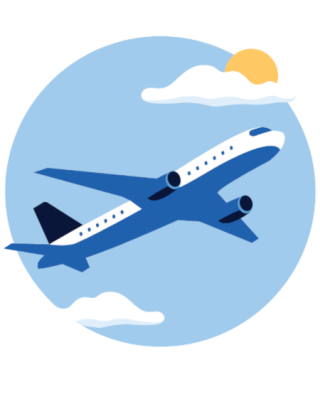
When you’re shopping for a ticket on United, the fare classes are listed under each ticket type.
For example, in the screenshot below, the top flight from Chicago to Frankfurt, Germany, has the following fare classes: S in economy, R in premium economy and P in business. The bottom flight has the following fare types: S in economy, A in premium economy and D in business class.
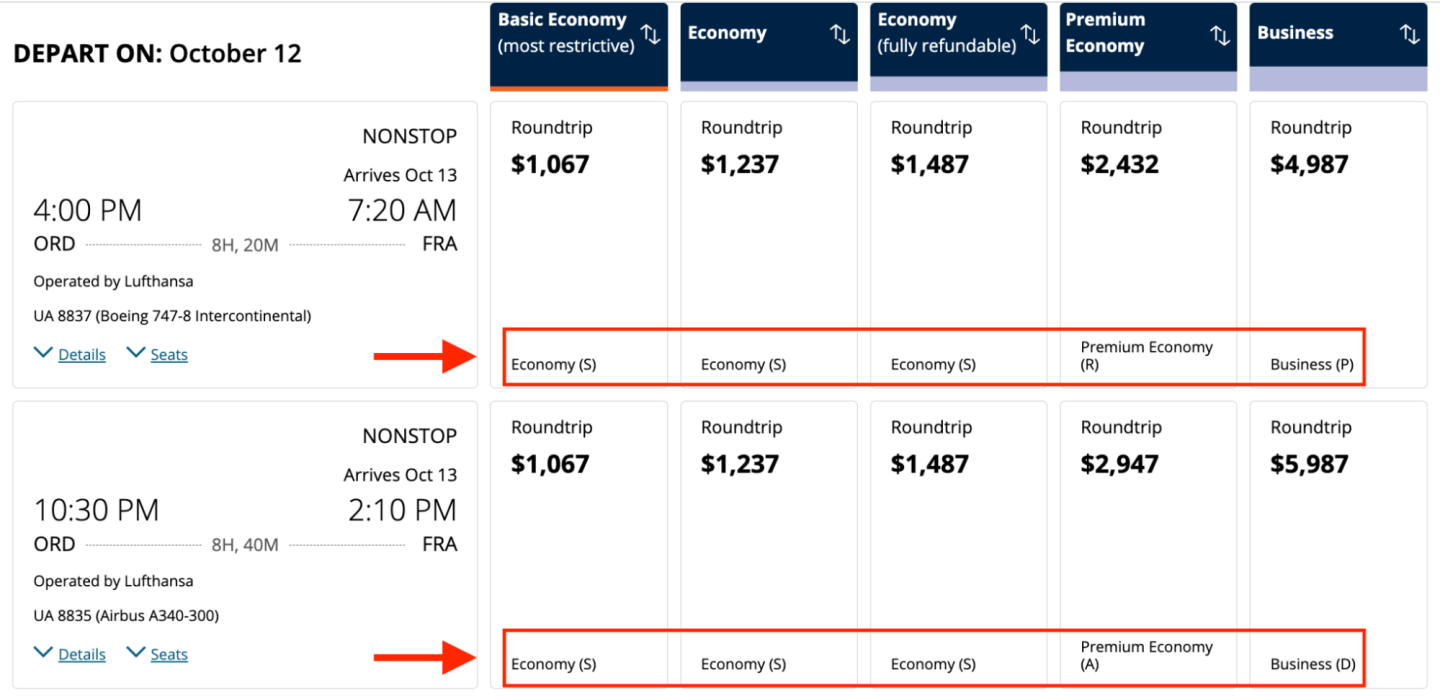
If you’re shopping for a flight on an online travel agency’s website, such as Expedia or Orbitz , you should be able to locate the fare class under “Details” once you select your flights but before you enter your credit card number.
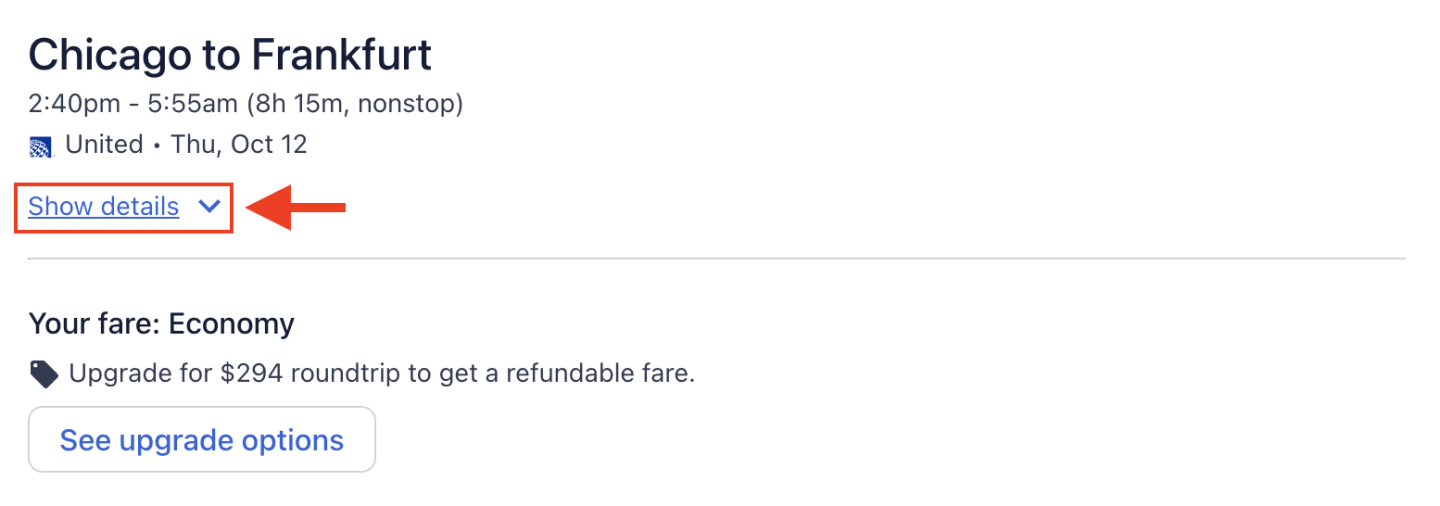
This ticket from Chicago-O'Hare to Frankfurt, Germany, has a fare class of S in the economy cabin.
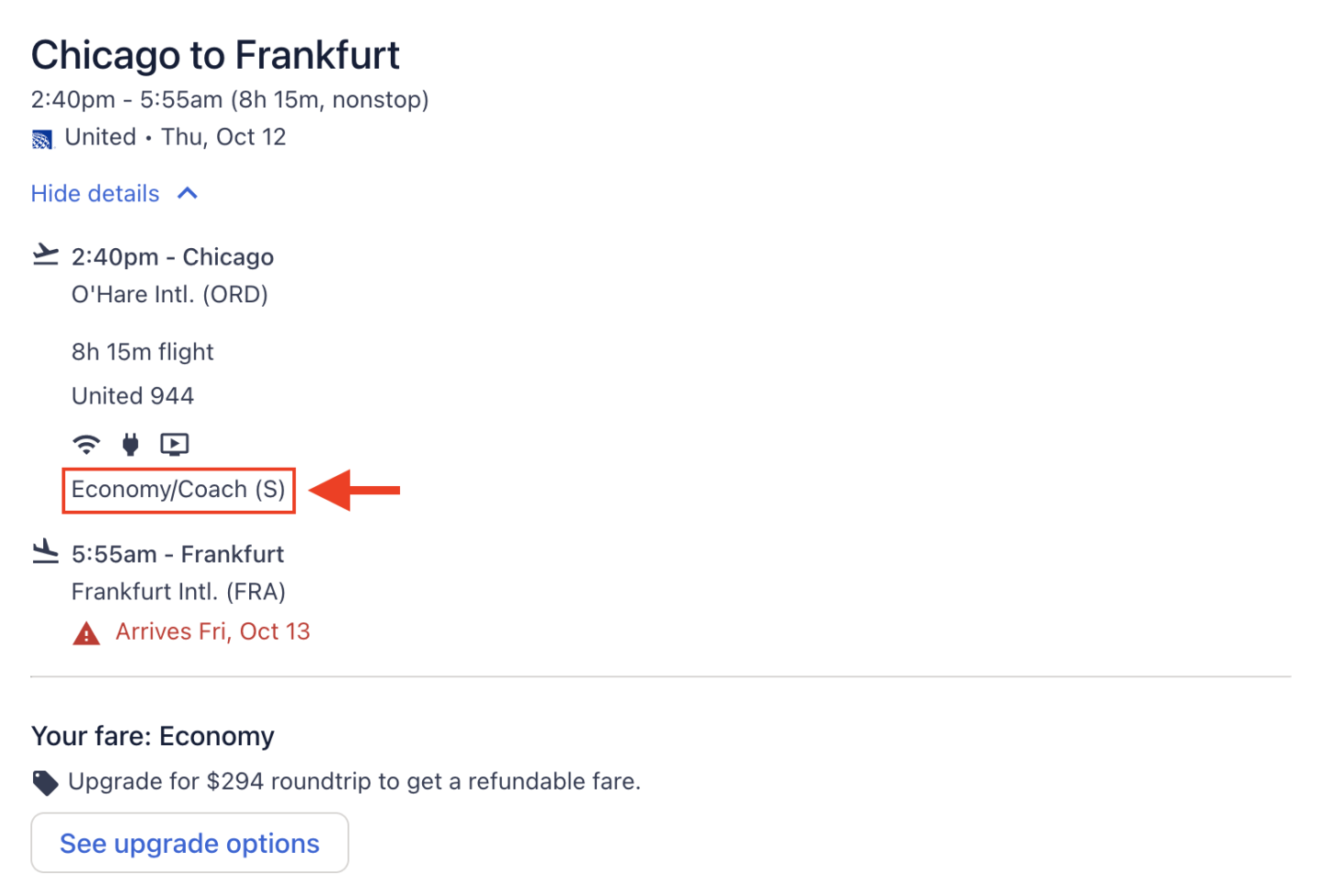
When possible, book your flights directly with the airline. This way, you avoid having to deal with a third-party booking site in case you need to change or cancel the flight or if there’s a cancellation by the airline.
There are some good reasons to pay attention to which fare class you’re booking. For one, your fare class (specifically, the price) can determine how quickly you earn elite status and whether you’re eligible for an upgrade.
Elite status qualification
Passengers achieve elite status by earning a combination of Premier Qualifying Flights (PQF) and Premier Qualifying Points (PQP) earned. PQF are based on the flight segments completed. So a nonstop flight counts as one PQF while a flight with one stop will count as two PQF. Basic economy tickets are an exception because they don't earn any PQF.
PQP is comprised of the base fare, carrier imposed charges, seat purchases and paid upgrades. So, the more expensive your flight, the more PQP you earn, and the faster you can achieve elite status.
» Learn more: The guide to United Airlines Premier elite status
Upgrade eligibility
To be eligible for an upgrade , you’ll need to have booked in the right fare class for the type of upgrade you’re requesting.
Complimentary Premier upgrades
If you’re a MileagePlus Premier flyer, tickets booked in certain fare classes are eligible for instant complimentary Premier upgrades (available on select routes). For example, economy tickets booked in fare classes Y or B for all Premier members, and tickets booked in fare classes Y, B or M for Premier 1K members, qualify for immediate upgrades to the premium cabin at booking.
The following routes are eligible for complimentary Premier upgrades:
Continental U.S. (except premium transcontinental routes).
Hawaii from Los Angeles or San Francisco.
Alaska, Canada, Mexico, Caribbean and Central America.
Guam and Micronesia.
Outside of instant upgrades, you can increase your chances of getting a complimentary Premier upgrade when you book a higher fare class than a fellow Premier member at the same status tier.
MileagePlus upgrades
If you’re not an elite flyer with United, you still have the option to upgrade a flight with MileagePlus miles. Depending on the fare class, your Premier status level and your flight route, you might be asked for a cash co-pay on top of the miles redeemed.
For example, tickets in fare classes B, O or Y don’t include a cash component. Tickets booked in most other fare classes will require a cash co-pay.
PlusPoints upgrades
Premier Platinum and Premier 1K members receive PlusPoints that can be used to upgrade United flights. Platinum members receive 40 PlusPoints upon reaching their status tier, and 1K members get another 280 PlusPoints, totaling 320 PlusPoints toward upgrades.
United charges 40 PlusPoints for upgrades from economy to Polaris business class and 80 PlusPoints for upgrades from discounted economy to Polaris on long-haul flights. So, if your ticket’s fare class is S, T, L, K or G then you’ll need 80 PlusPoints for an upgrade to Polaris. Otherwise, you’ll just need 40 PlusPoints for your upgrade.
Additionally, if you’re a Premier 1K member, some fares make you eligible to skip the waitlist and confirm an upgrade right away, as long as your flight is on an eligible international route and is more than 30 days out. Those fares include:
From United Premium Plus to United Polaris business class: O, A and R.
From United economy to United Polaris business class: Y, B, M, E, U, H, Q, V and W.
From United economy to United Premium Plus: Y, B, M, E, U, H, Q, V, W, S, T, L and K.
When crediting miles to a partner program
Another time you should pay attention to fare classes is when you’re crediting a flight to a partner program. Say you’d rather earn miles with Air Canada Aeroplan , who is a Star Alliance partner of United, and you want to know the earning rates.
You’ll earn the following number of Aeroplan points and Status Qualifying Miles (SQMs) when crediting paid United flights to Aeroplan:
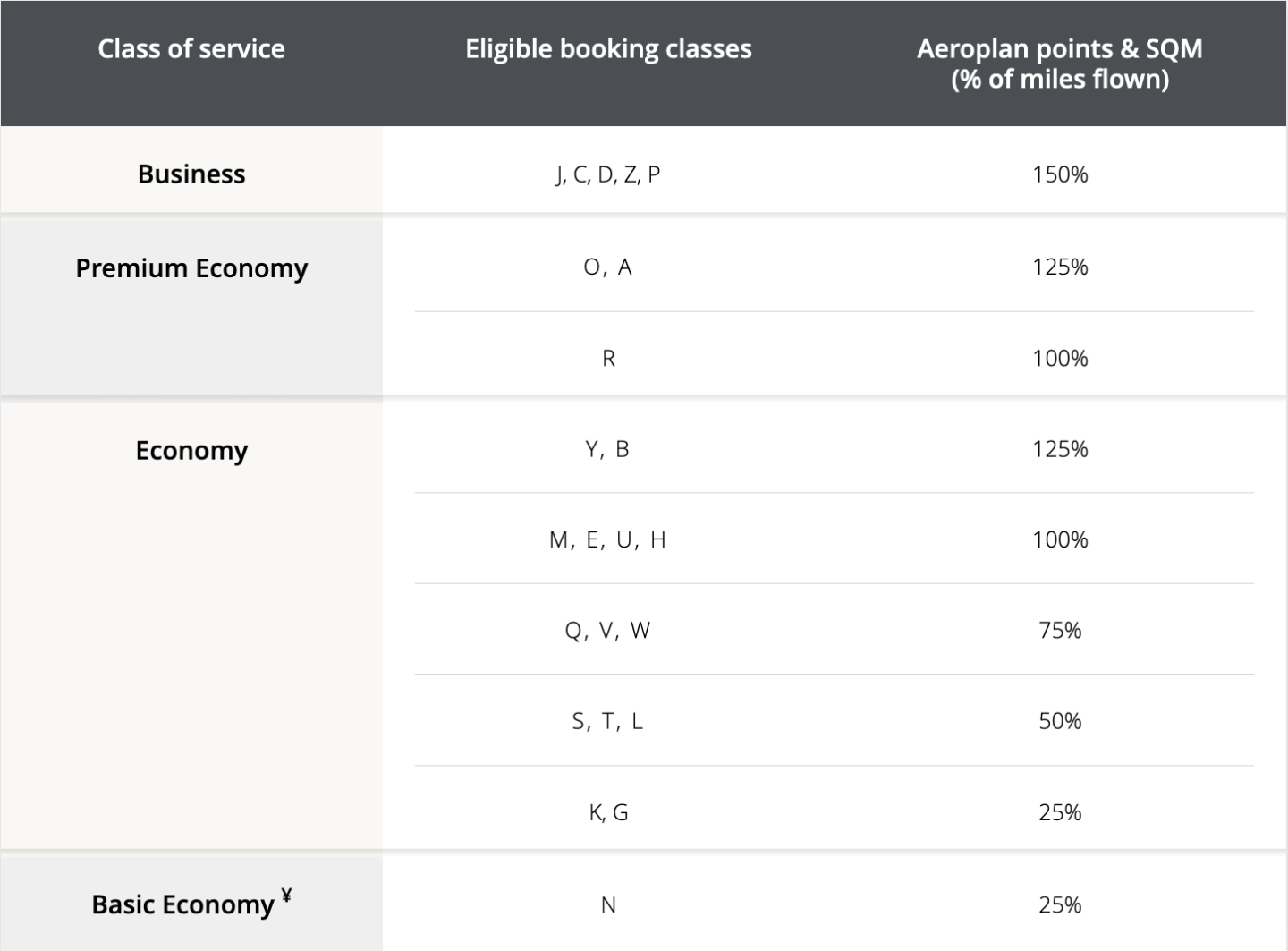
If you’re a member of multiple airline loyalty programs and can’t decide where to credit your flight, check out WhereToCredit , a website that shows you how many miles you’d earn in any frequent flyer program for a particular flight. This can help you make sure you're earning the highest possible number of redeemable miles.
Let’s say you’ve booked a United economy ticket in fare class V and want to know where to credit this flight. Go to the WhereToCredit website, select the airline and fare class and view the results.
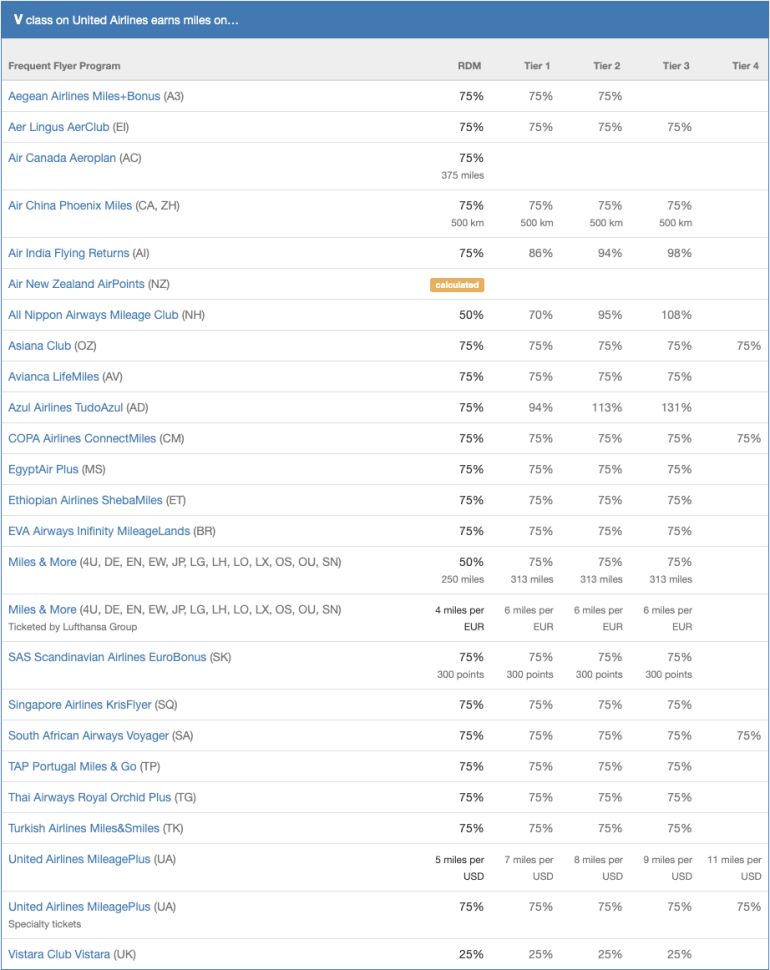
Based on the results, you’d earn 5 miles per base dollar spent on the ticket with United MileagePlus (as a general member), 50% of the flight distance with ANA Mileage Club and Miles & More and 75% with all the other partner programs, so you can take your pick of the programs earning more miles.
» Learn more: How to save money on United Airlines flights
Travelers often don’t care which fare class they book as long as the ticket price is low. However, if you’re chasing status or want to book an upgradeable ticket, there are ways to search for specific fare classes on United.
Go to United.com and select “Advanced search.”
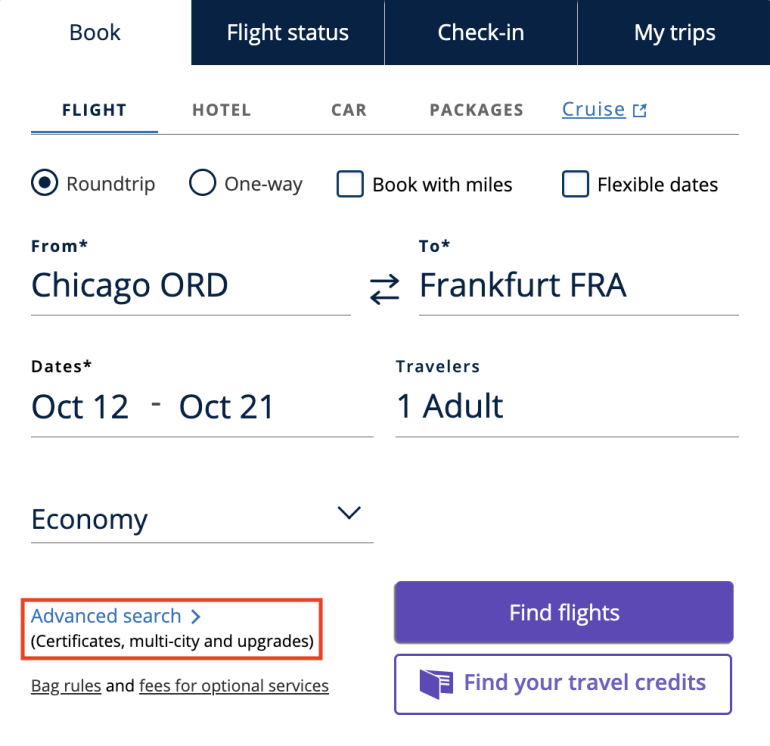
Enter your flight search details as usual and scroll down until you see a “Fare class” box. Fill in the fare classes you’re looking for and click on “Find flights.”
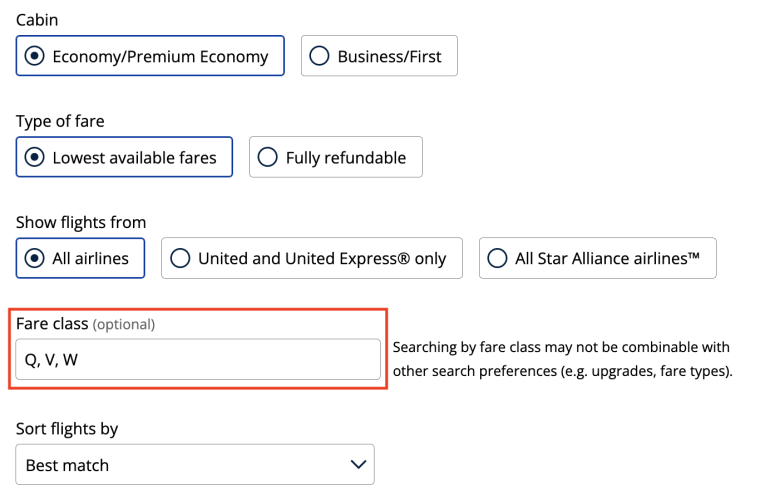
On the results page, you’ll see the regular search results for all other booking classes as well as a column with the requested fare classes.
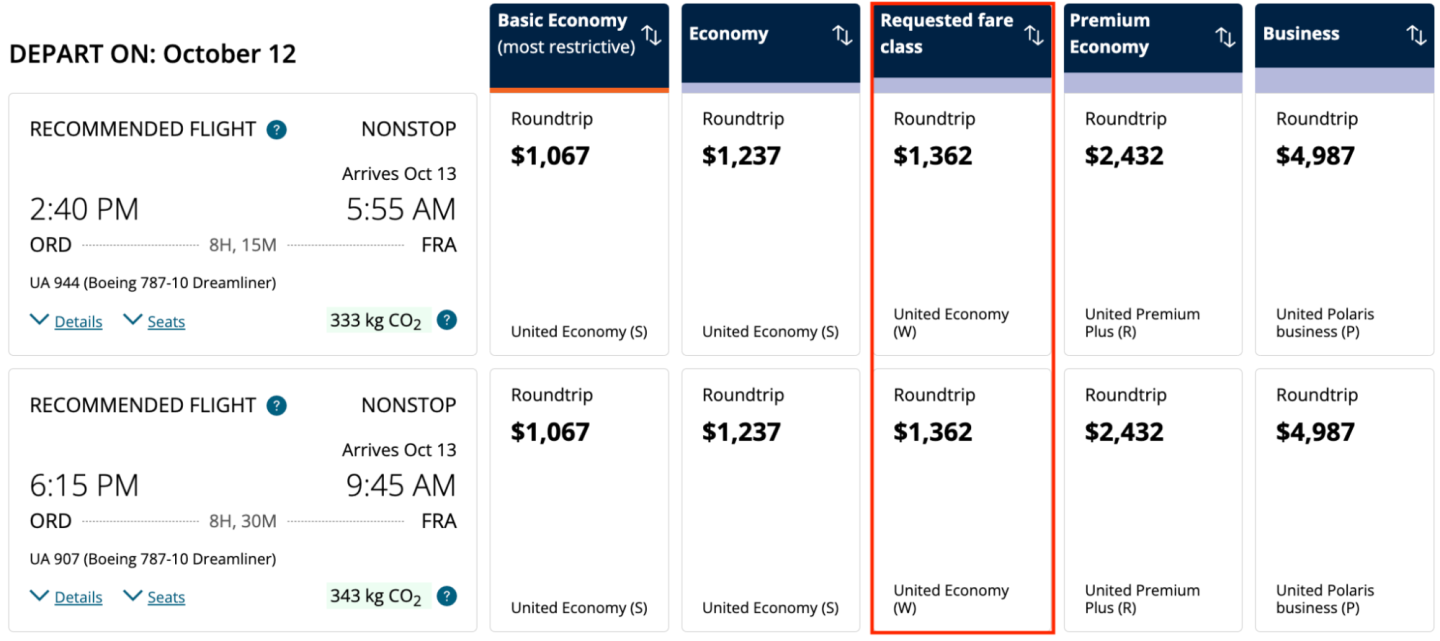
This way you can compare ticket prices and decide whether booking a specific fare class is worth it or not.
Secure the best earning rates and benefits for your United flight needs by purchasing your tickets with the right credit card.
Here are a handful of Chase United credit card options — or you can read NerdWallet analysis on which are the best .
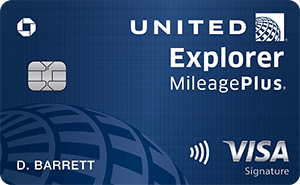
on Chase's website
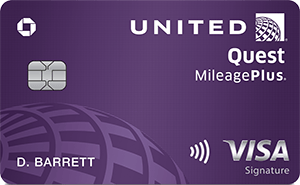
$0 intro for the first year, then $95 .
• 2 miles per $1 on United purchases.
• 2 miles per $1 at restaurants and hotels (when booked directly with hotel).
• 1 mile per $1 on all other purchases.
• 3 miles per $1 on United purchases.
• 2 miles per $1 at restaurants, select streaming services and all other travel.
• 4 miles per $1 on United purchases.
• 2 miles per $1 at restaurants and all other travel purchases.
• 2 miles per $1 on United purchases, gas stations and local transit and commuting.
• First checked bag free for you and one companion on your reservation.
• 2 United Club one-time passes each year.
• Credit of up to $100 every four years for TSA PreCheck, Global Entry or NEXUS.
• Priority boarding.
• No foreign transaction fees.
• First and second checked bag free for you and one companion on your reservation.
• $125 United purchase credit per year (good on airfare).
• Two 5,000-mile award flight credits per anniversary year.
• Access to United Club airport lounges.
Earn 50,000 bonus miles after you spend $3,000 on purchases in the first 3 months your account is open.
Earn 60,000 bonus miles and 500 Premier qualifying points after you spend $4,000 on purchases in the first 3 months your account is open.
Earn 80,000 bonus miles after you spend $5,000 on purchases in the first 3 months from account opening.
Earn 20,000 bonus miles after you spend $1,000 on purchases in the first 3 months your account is open.
If you seek more flexibility in redeeming miles for award flights, consider applying for a more general travel credit card instead. A more general travel credit card differs from an airline card in that you can book flights with multiple carriers, rather than reaping the benefits of staying loyal to a single brand.
The more high-end (or 'premium' ) the travel credit card, the more benefits you can enjoy, including airport lounge access or automatic elite status in certain programs. That said, a brand-specific airline card can net you benefits like waived baggage fees, which can have meaningful dollar value.
» Learn more: Is a United credit card worth it?
The United fare class you’ve booked can make all the difference between qualifying for an upgrade or not, how much the upgrade is going to cost in miles or cash, and how many miles and segments toward elite status you’ll be earning.
United makes it easy to find your specific fare class before or after you book a flight. It's smart for United elites in particular to pay attention to fare classes, as booking the right one could make you more likely to score an upgrade.

How to maximize your rewards
You want a travel credit card that prioritizes what’s important to you. Here are some of the best travel credit cards of 2024 :
Flexibility, point transfers and a large bonus: Chase Sapphire Preferred® Card
No annual fee: Bank of America® Travel Rewards credit card
Flat-rate travel rewards: Capital One Venture Rewards Credit Card
Bonus travel rewards and high-end perks: Chase Sapphire Reserve®
Luxury perks: The Platinum Card® from American Express
Business travelers: Ink Business Preferred® Credit Card
1x-2x Earn 2 miles per $1 spent on dining, hotel stays and United® purchases. 1 mile per $1 spent on all other purchases
50,000 Earn 50,000 bonus miles after you spend $3,000 on purchases in the first 3 months your account is open.
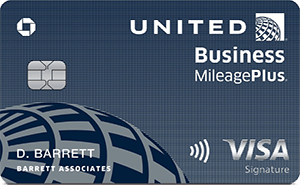
1x-2x Earn 2 miles per $1 spent on United® purchases, dining, at gas stations, office supply stores and on local transit and commuting. Earn 1 mile per $1 spent on all other purchases.
75000 Earn 75,000 bonus miles after you spend $5,000 on purchases in the first 3 months your account is open.
1x-3x Earn 3x miles on United® purchases, 2x miles on dining, select streaming services & all other travel, 1x on all other purchases
60,000 Earn 60,000 bonus miles and 500 Premier qualifying points after you spend $4,000 on purchases in the first 3 months your account is open.

Travel classes
Choose your perfect way to fly. Our cabins cater to everyone so you can expect the same great, and uniquely British, experience whether you’re flying First or economy.
Discover great value fares and family-friendly service. Fly to the UK and Europe in Euro Traveller or go long-haul in our World Traveller cabin.
Premium economy
Fly premium economy with World Traveller Plus and treat yourself to a wider seat, longer legroom and priority boarding - all in a separate cabin with an extra checked bag.
Work or relax in style with lounge access, dedicated check-in and fully flat beds on long-haul. Fly short-haul with Club Europe or to the rest of the world with Club World. Our new Club Suite is also available on selected flights.
Indulge in the most exceptional comforts from luxurious fine dining to your own private suite. With access to our elegant departure lounges and exclusive service as standard, First truly is the finest way to fly.
Travelling on partner airlines
If your flight number begins with anything other than ‘BA’ (e.g. AA123456X), you’re flying with one of our partners.
To learn about travel classes on our partner airlines, please use the links below:
American Airlines
Japan airlines, qatar airways, china southern airlines.
Everything you need to know about British Airways’ fare classes

Editor's note: This story has been updated with new information.
Have you ever heard someone say something along the lines of, "I'm flying in J" and wondered what on earth they could mean?
Or, have you checked your flight on ExpertFlyer and been surprised by the sea of letters showing for each British Airways flight when you know there are only four actual classes the airline flies — First , Club World / Club Suite (business), World Traveller Plus (premium economy) and World Traveller (economy)?
Follow The Points Guy on Facebook and Twitter , and to ensure you never miss anything, subscribe to our daily newsletter .

Why so many fare classes?
British Airways has 22 fare classes and four redemption classes. Revenue fare classes are bookable for cash whilst redemption fare classes are for Avios or mileage bookings.
Broadly speaking, the different fare classes within each cabin correlate both to the cost of the ticket as well as the flexibility of the fare offered. The lower classes usually sell first, so as a flight gets busier, the lower classes will fill up and BA will only sell higher, more expensive fare classes. Typically, the closer to your travel date, the higher the fare class — either because the plane has filled up anyway or because BA might only sell higher fare classes closer to the departure date, as it knows it can command higher prices for last-minute bookings.
BA's fare classes break down as follows:
- First: F (flexible) and A (discounted) as revenue fare classes and Z for reward redemptions;
- Club World (business class): J, C, D, R and I (with I being the cheapest) for revenue and U for reward bookings;
- World Traveller Plus (premium economy), W, E and T for revenue and P for reward bookings; and
- World Traveller (economy): Y, B, H, K, M, L, V, S, N, Q, O, G and P for revenue and X for reward bookings.
It's worth noting that based on which fare class you're booked in, the number of Avios you'll get in return will vary.
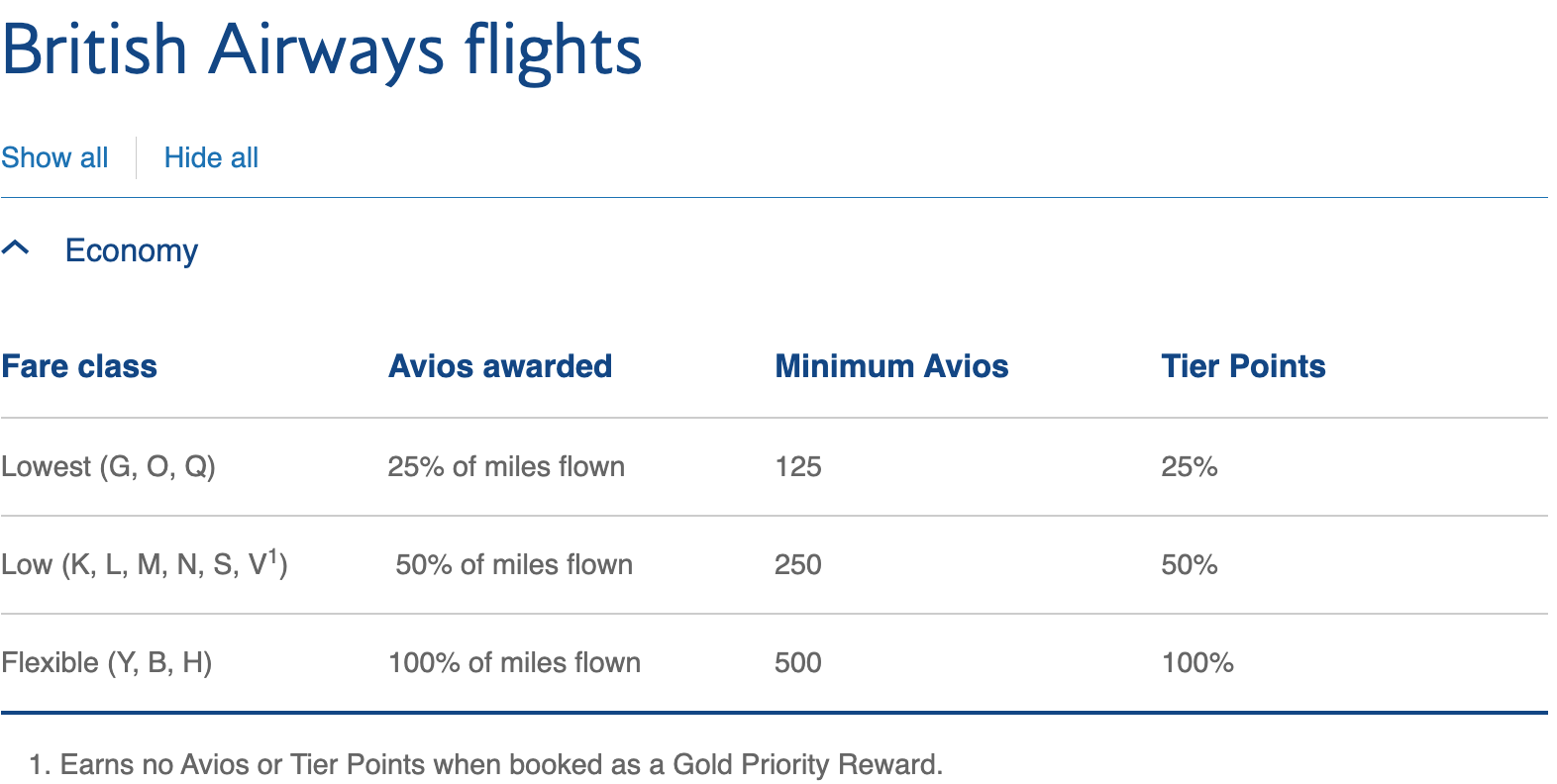
The table above shows the breakdown of Avios and Tier Points for BA's different fare classes. For example with the lowest economy classes (G, O and Q) you'll earn 25% of the miles flown and 25% of the Tier Points. A mid-range fare, such as this example roundtrip itinerary from Newark (EWR) to London (LHR), will earn you half of the miles flown. In this case, since it's an L class Basic Economy, you would earn 3,458 Avios.
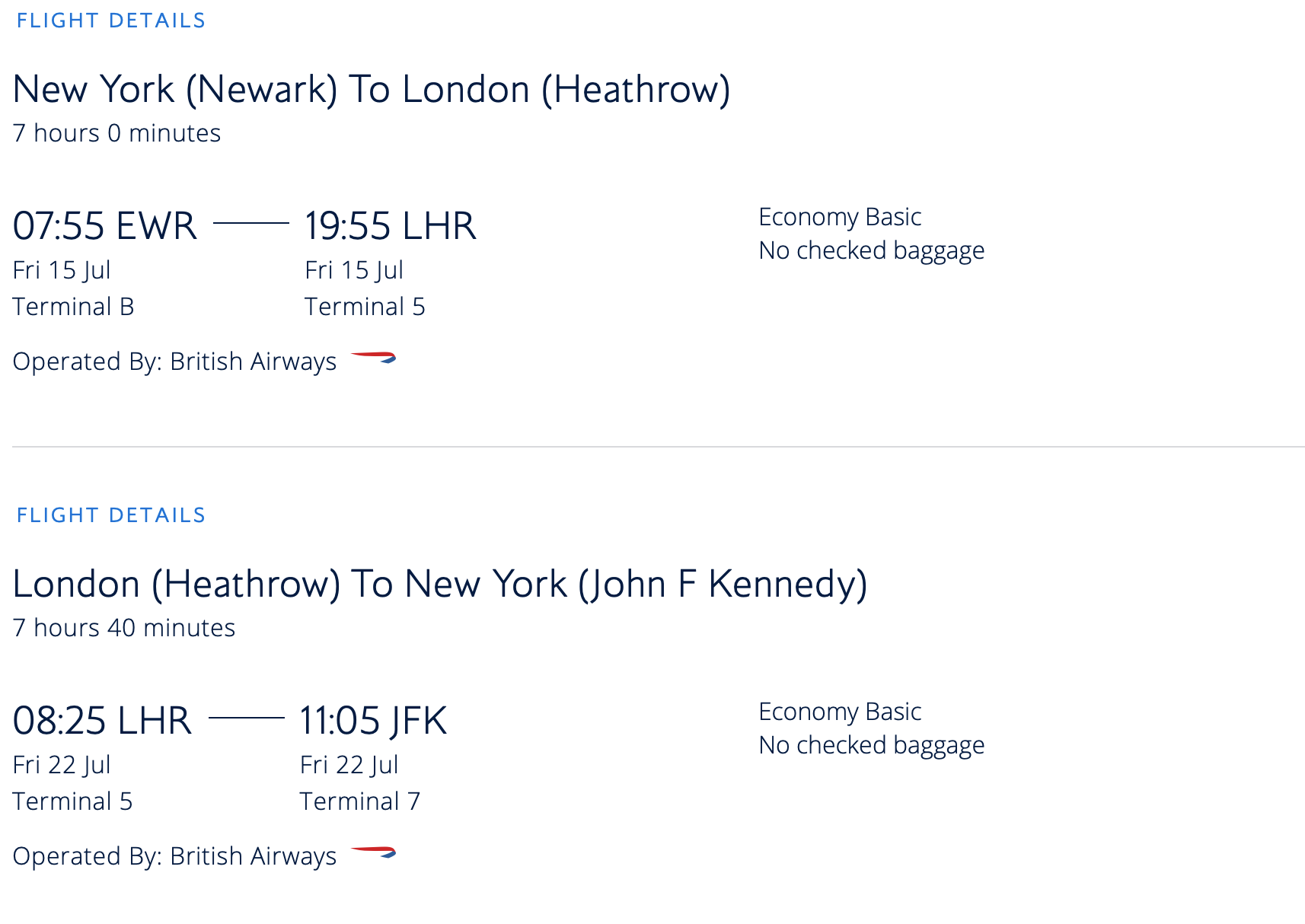
If I book the same flight but choose a Premium Economy seat (a T class fare), I would earn 100% of the miles flown in Avios, which in this case would be 6,916.
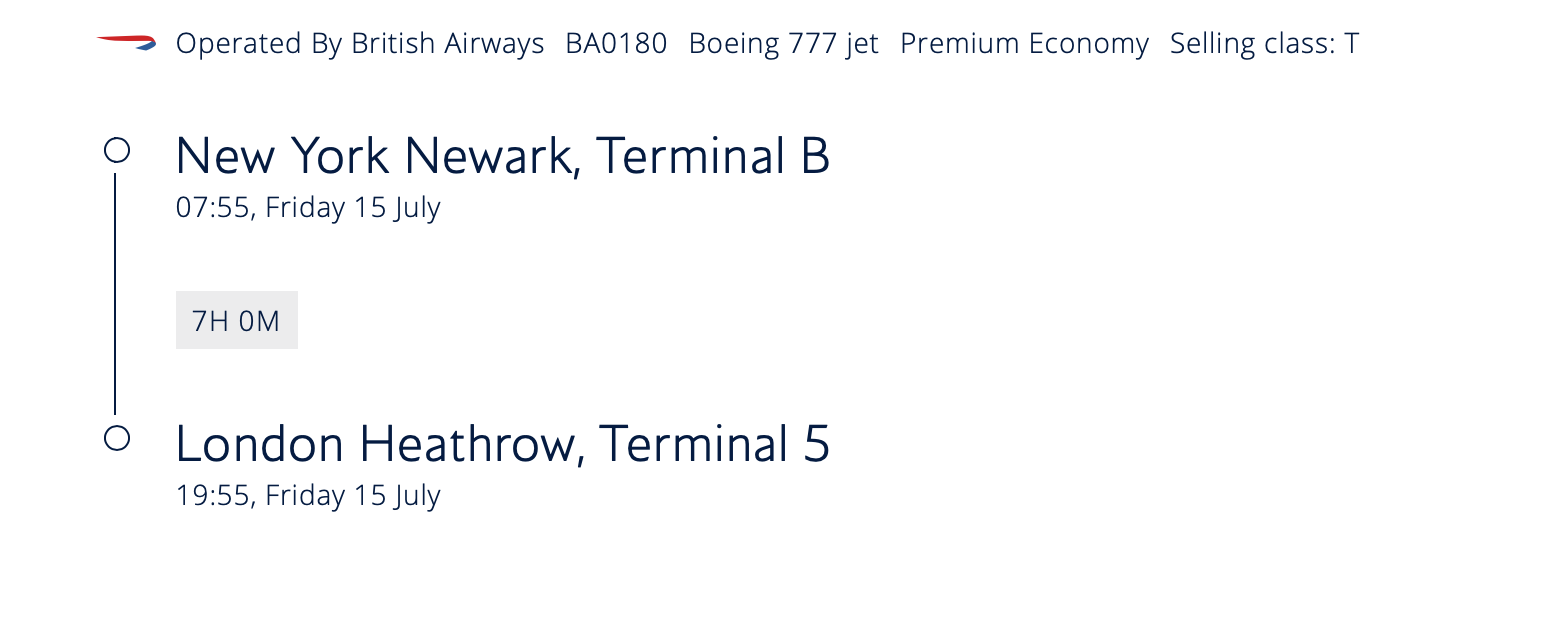
It's also worth noting that G class, one of the most heavily discounted BA fare classes in economy, is reserved for travel agent bookings , including BA holidays. That's why it sometimes pays to add a car or hotel to your booking — that way, you might be able to book into G even if booking the flight on its own would only let you book into a higher fare class.
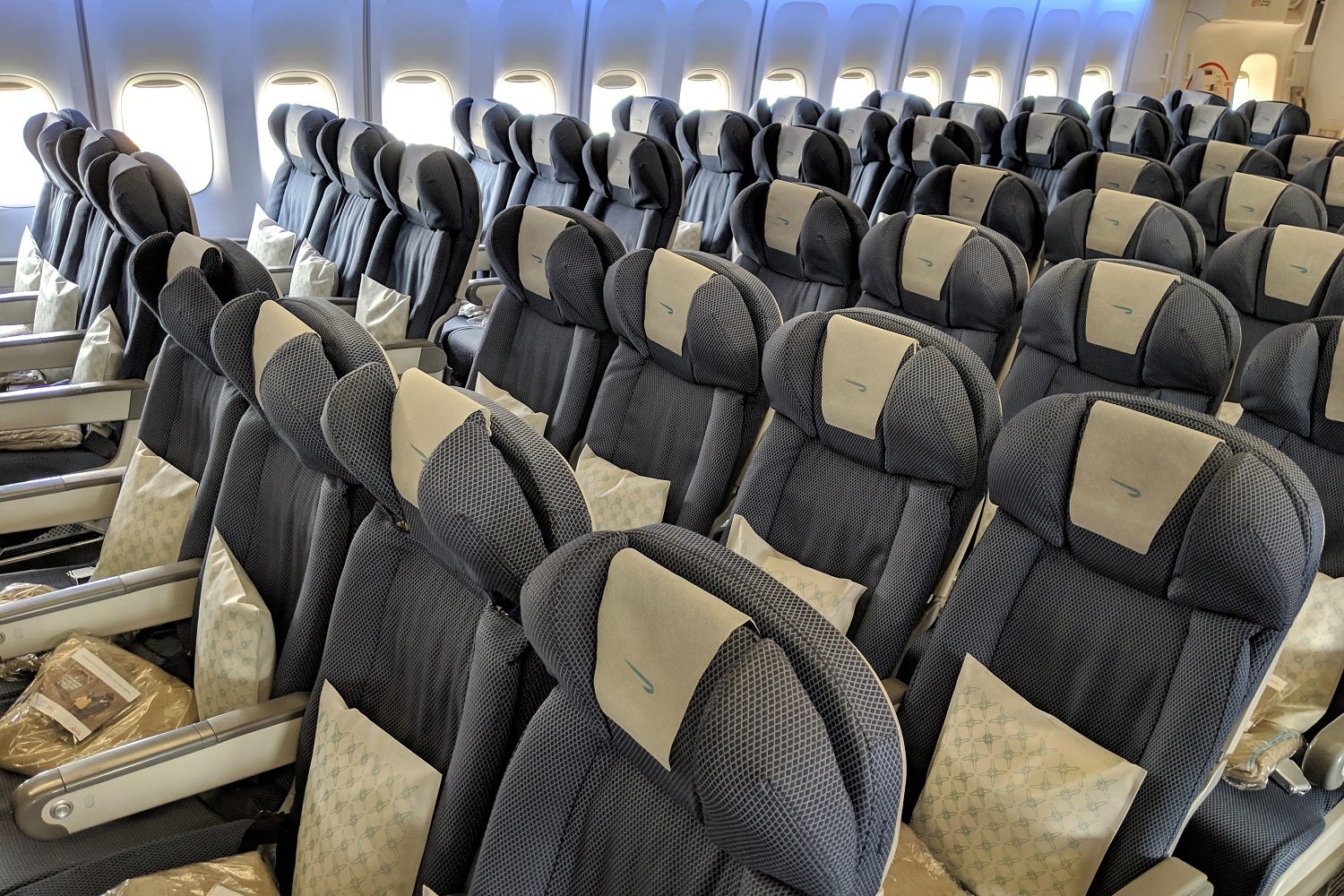
What the numbers mean
In the example above, the sea of 9s doesn't mean that there are only nine seats available in each class. Nine is the highest number that can be displayed for BA (for some airlines it's seven), and the fare classes are all related. For example, if you book nine seats in O class, it's highly likely that there won't be nine available in Q and that number goes down. That's why you might see BA offer four seats for sale on a flight when there's actually only one left .
Looking at a week-long trip to New York in February next year, a return ticket in Y, which is a fully flexible economy class, costs £2,291. The same ticket can be had for £301 if choosing the cheapest option, O class. The latter does not allow any bags or seat selection, and nor does it allow any changes, whilst the former is fully flexible, as the passenger can change the time, date and receive a full refund if it needs to be cancelled.
Despite the £2,000 price difference between the two tickets, the seat and food for those two tickets would be exactly the same. Of course, there are good and bad seats in each — our guides help you pick the best seats in any BA cabin .
The crazy thing about the fully flexible example economy price is that discounted premium economy can be had for £587, and even discounted business class can be had for £1,333 — a saving of £700 from that fully flexible economy seat. Now, that's a sale price (and a decent one from London ) and has no flexibility. In other words, you couldn't change dates nor get a refund.
![travel class mean [UNVERIFIED CONTENT] Aerial view of one of Terminal 5 buildings of London Heathrow Airport and Boeing 747 and 777 aircrafts operated by British Airways at the gates on Wednesday, June 26, 2013. (Photo by Grzegorz Bajor/Getty Images)](https://i2.wp.com/thepointsguy.co.uk/wp-content/uploads/2019/08/GettyImages-175377092.jpg?fit=600%2C400px&quality=1#038;ssl=1)
Bottom line
Understanding fare classes and how you can use them in conjunction with ExpertFlyer can help you find cheaper flights. If the particular flight or day you are looking for doesn't have the price you were expecting or hoping for, it's worth having a browse on ExpertFlyer to find a date that has lower fare classes available. In addition to also helping you understand what you'll earn on the flight, you'll be able to impress your AvGeek friends at the next dinner party.
- Search Please fill out this field.
- Manage Your Subscription
- Give a Gift Subscription
- Newsletters
- Sweepstakes
- Airlines + Airports
The Main Differences Between Business Class vs. First Class — and Tips for Booking Each
Here's what to know about each premium cabin type — and how to book them.
:max_bytes(150000):strip_icc():format(webp)/Stefanie-Waldek-7eed18a8c9734cb28c5d887eb583f816.jpg)
Business Class
Domestic first class, international first class, how to book (or be upgraded to) business class, domestic first class, and international first class.
imaginima/Getty Images
If you're tired of flying in economy, it might be time for an upgrade. For a more enjoyable flight, booking a premium cabin — that is, business class, domestic first class, or international first class — provides vast improvements. But each of the cabins offers a fairly different experience, and it's important to know what to expect with each. Here's everything you need to know about the premium cabins available on planes today.
- Typically lie-flat or angled seats
- Multicourse plated meal service
- Priority check-in and boarding
- Extra baggage allowance
- Lounge access
- Amenity kits
- Business class seats, amenities, and services vary greatly per airline and aircraft
- Usually a very expensive option
- No complimentary upgrades
Business class is a premium cabin available on international long-haul flights . Seats are typically lie-flat or angled, not just recliners, offering far more space than in the economy or premium economy cabins . Service is elevated both in the air, from free alcohol to plated multicourse meals, and on the ground, from priority check-in and boarding to lounge access. But not all business-class cabins are created equal. Some more outdated products lack in seat comfort and privacy, while newer ones might include closed-door suite-style seats with extra space. Even within an airline, business-class cabins can vary greatly on different aircraft. Pricing is dramatically greater than economy, often thousands of dollars no matter the route.
Bloomberg/Getty Images
- More spacious and comfortable seats
- Often served plated meals
- Complimentary upgrades for elite status holders
- Not as expensive as business class or international first class
- Typically no lie-flat seats
- Lounge access is not guaranteed
Domestic first class is the top cabin on domestic flights and some short-haul international flights. On most airlines and aircraft, this means you'll sit in a recliner-style seat that offers more space and legroom than economy. Some transcontinental flights, however, may have business-class lie-flat seats, but this varies based on the airline and aircraft. On flights that are a few hours or longer, you'll be served plated hot meals, and on all flights, alcohol is complimentary. Before your flight, you'll receive priority check-in services (including extra baggage allowances), but you usually won't receive lounge access. You'll be one of the first groups to board your plane. The tickets cost more than economy, of course, but they're typically not as expensive as business-class fares — perhaps a few hundred up to a thousand dollars.
- The most privacy, with some seats being fully enclosed
- Fine dining
- First class-only lounges at some airports; general lounge access at others
- Only available on certain airlines and aircraft
- The most expensive option
International first class is the ultimate flying experience — it's the best cabin across the board on commercial aircraft, ranked above business class, and it has the price tag to match. Many airlines don't even offer an international first class; a few notable ones that do have the product include Singapore Airlines , Etihad, and Air France. What makes the cabin so exceptional is the space and privacy of each seat. On some airlines, first-class seats are private suites with closed doors. The dining experience is usually elevated beyond that of business class, with fine wines and over-the-top menu items. As with business class, you'll receive a number of perks on the ground, from priority check-in to exclusive lounge access — some airlines have special first-class lounges that are not accessible to frequent fliers or business-class travelers. And, of course, expect to board in one of the first groups. You'll find this type of first-class cabin on international long-haul flights only — and solely on certain routes on certain airlines.
NurPhoto/Getty Images
You likely already know you can select any of these classes instead of the economy cabin when booking a flight. And you're probably also aware you can use either cash or miles to purchase seats in business or first class.
But what you might not know is that on most airlines, there are other ways to score an upgrade — though it likely won't be free.
Paid Upgrades
It's often possible to pay for upgrades to business or first class in cash or miles later on, depending on availability — and they might be cheaper than the full price at booking. "A lot of airlines these days will tempt you with an option to upgrade during the check-in process that sometimes can be cheaper than buying a business ticket outright," Katy Nastro, travel expert at Going , tells Travel + Leisure . "If this is your game plan, don’t always count on the ticket being downright cheap. It will still be more expensive than your original ticket price, and it all depends on if there is any availability in a higher class."
Even after check-in, you can ask an agent at a transfer desk if you're on a layover or a gate agent if there are any paid upgrades available. "Sometimes, airlines have unsold premium seats that they're willing to upgrade passengers to at a lower cost," Kristin Winkaffe, founder of Winkaffe Global Travel , tells T+L. "It's a bit of a gamble, but it's always worth politely inquiring at the gate if any upgrade options are available. This method can be especially fruitful if you are traveling during off-peak times."
Meet the Expert
Katy Nastro is a travel expert at Going, a website that finds flight deals to more than 900 destinations around the world.
Kristin Winkaffe is the founder of Winkaffe Global Travel, a travel agency with a focus on sustainability and off-the-beaten-path adventures.
Bidding on Upgrades
Additionally, some international airlines allow you to bid on upgrades to premium cabins before your flight. "It's like an auction; you make an offer, and if it's accepted, you get upgraded," says Winkaffe. "The key here is to make a reasonable bid, keeping in mind the flight duration and destination."
Free Upgrades
If you're a "regular" passenger, you probably won't get a free upgrade. "Don’t fall into the trap of thinking that dressing nicely will afford you an automatic upgrade. This is a travel myth that might have been true decades ago, but is just not the case today," says Nastro.
But if you're a frequent flier with elite status, complimentary upgrades are one of your perks — on domestic flights and limited short-haul international trips, that is. Elites can request to be added to the complimentary upgrade list on certain flights, with seats doled out based on availability. "A warning for these methods, though — you will need to fly quite a lot to really reap the rewards of elite status," says Winkaffe. "It's a long-term strategy, but definitely rewarding for those who travel often."
There is one rare case in which you may be able to score a free upgrade without status: accepting a voluntary bump on an oversold flight. "When a flight is oversold, you may see the airline ask for volunteers to switch, and likely will sweeten the deal with cash," says Nastro. "To sweeten the deal even more, inquire whether they would be able to upgrade you on the alternate flight if you give up your seat. No guarantees this will work, as sometimes policies prevent it, but it doesn't hurt to ask."
Related Articles
- Sustainability

Coming Soon
Launching later this year, you will be able to create a Travel Radar account for use across our website and upcoming mobile apps. Subscribe for additional features, an ad free experience and more. That's all we can say... for now!
Ticket classes: Why ‘Y’?

Have you ever looked at your airplane ticket, and wondered what some of the letters stamped on it mean? Does it make any difference which letter of the alphabet you happen to have on your boarding pass?
Different letters can be used by different airlines, but there are some that tend to remain the same.
Next time you are able to take a look at your air ticket, here are some of the letters you are likely to see, and what they mean:
First class: A or F
Full fare business: C, D or J
Discounted business: I or Z
Premium economy: E or W
Full-fare economy: B, H, M or Y
Discount economy: K, L, N, O, Q, S, T, U, V, X

So, those are the codes. But why does it matter? Does it really make a difference if your ticket says J rather than C, or B rather than K, for example?
Well, yes actually. The code on your ticket will determine such things as whether you have a flexible fare, which will allow you to make changes to your booking without incurring heavy costs. It can also show how many air miles you are likely to accumulate if you are part of a frequent flyer program. You may find that if you have several legs of air travel on your journey, you have several codes.
If you are travelling 1,000 miles with a code D for example, this might give you 1,750 frequent flyer miles. But you may get only 500 miles for a Z class.
Becoming very familiar with what the code letters mean can help you to maximize your frequent flyer miles. Because codes differ between different airlines and the rewards will also vary, it is easiest to make yourself an expert on one or two of your preferred airlines rather than trying to figure out what all of the codes across all of the airlines might mean for you.
Airbus Secures Contract with European Space Agency to Develop Solar Storm Monitoring Satellite
Iag’s financial performance resulted in a loss in first quarter of 2024, southwest airlines’ financial performance results in loss in first quarter of 2024, boeing postpones first-ever crewed launch of its starline spacecraft again due to a valve problem, turkish airlines partners with airbus and rolls-royce to enhance turkey’s aerospace capabilities.

LEAVE A REPLY Cancel reply
Save my name, email, and website in this browser for the next time I comment.
The leading digital hub for all things aviation and air-travel! Discover the latest aviation news, data, insight and analysis from our team of journalists!
- Contact Travel Radar
- Corrections
- Contribute/Write for Us
- Jobs & Internships
- Privacy Policy
Editor's Choice
What happened to the airbus a360 and a370, heroes of the sky: the top 7 greatest emergency landings in history.
© Travel Radar Media Ltd. 2015-2024| ISSN #2635-0696 | Trademark #UK00003579704
Session expired
Please log in again. The login page will open in a new tab. After logging in you can close it and return to this page.
Woman Wrongly Charged Forty Thousand Dollars By Qantas Airline
Aeroflot restarts international flights.
A guide to the 8 types of RV explained, from Class A to camper vans
- RV sales have been increasing as people have started looking for ways to travel during the summer while still social distancing.
- There are several RV and RV trailer types available on the market.
- For those looking to purchase or rent an RV for summer trips, here's a guide explaining the different RV class and trailer types.
- Visit Business Insider's homepage for more stories .

RVs and RV trailers are no longer just for older folks looking for post-retirement travel plans or suburban families looking for a summer getaway.
RV sales started skyrocketing when states started their first rounds of lifting stay-at-home orders. And now, RV interests have been hitting new customer segments, such as millennials looking to fulfill their "digital nomad" dreams.
But for first-time home on wheels buyers and renters, the RV and RV trailer market may seem daunting.
Each RV and trailer type differs from the other in size, floor plan, weight, and design to fit the needs of different customers. For example, large toy hauler trailers allow families to bring both their children and their ATVs and kayaks on the trip. But other trailer types, such as the teardrop, may not even include an interior kitchen due to its smaller size.
Whether you're looking to purchase your first RV, or you've been browsing RV rental platforms Outdoorsy and RVshare for a weekend RV getaway here's a list of different RV and trailers, explained:
Class A: the largest RV.
Class A RVs are the largest of the three RV classes.
According to Outdoorsy , Class As are typically built on a diesel or gas-powered vehicle, commercial truck, or commercial bus chassis. This expansive size allows its interior to have the same amenities as any traditional foundation-based home, although this often means it can be the most expensive RV type.
Because of this, the Class As are a popular choice for people who want a luxuriously large RV for full-time living on the road, according to General RV .
Class B: the smallest RV.
The Class B is the smallest motorhome of all three classes.
This segment is commonly otherwise known as a camper van or a converted van. It's also currently popular among many millennials looking to pursue #VanLife , and recently, many van conversion companies have seen a skyrocketing request in builds .
Because Class Bs are often small, the vehicles typically don't include the same spacious amenities as a Class A. However, it's still possible to have the kitchen, bathroom, bedroom, and dining area basics with the right floor plan by being creative and integrating multi-purpose furniture, such as a dining table that can be flipped into a sleeping space.
Related stories
Class B's are also easier and cheaper to operate and don't require any kind of special driver's license.
Nowadays, many Class B RVs in the US are built on Ford Transits, Mercedes-Benz Sprinters, and Ram Promasters.
Class C: the in-between RV size.
As counterintuitive as it is, the Class C RV is smaller than a Class A, but bigger than a Class B.
Class Cs are known as "versatile" RVs that have more space for amenities and beds with its average length sitting between 20 to 31 feet, according to Outdoorsy . The class can also often be identified by the over-cab sleeping area, according to Expedition Motor Homes .
Class C RVs are often built on the chassis of pickup trucks or vans, making it more fuel-efficient and less expensive than the Class A.
Pop-up camper: the camping tent on wheels.
Pop-up campers are towable units that can be expanded by unfolding its sides, which are often made of canvas, according to RVshare . This makes it similar to a more structured, above-ground camping tent that's more affordable than other RV or trailers, according to Outdoorsy .
And because the pop-up campers have lightweight foldable components, they can often be easily towed.
Pop up campers typically range between eight feet to 16 feet, although this size expands when the roof is popped up and unfolded, according to Popup Advice .
Travel Trailer: the most popular trailer.
The travel trailer category is relatively broad, but this versatility means it can fit many sizes, floor plans, amenities, and budget requirements that customers may have. According to Thor Industries , it's also the most popular towable with a length between 13 to 40 feet.
Travel trailers often require a pickup truck, SUV, or van with a hitch to be towed, according to Outdoorsy .
Fifth Wheel Trailer: the largest trailer.
Fifth wheels are the largest RV trailer segment available and can often be identified by its raised extension like that of an over-cab in the Class C RV segment. This extension then hangs over and attaches to the vehicle that is towing it, which is often a pickup truck, according to Thor Industries .
Fifth wheels average between 25 to 40 feet. Due to this size, fifth wheels often have plenty of space for rooms and amenities. This also makes it a good trailer for those who want to travel with a larger group of people or folks who plan on camping at a single site for a longer time.
Teadrop Trailer: the tiny rounded trailer.
Teardrop trailers fall on the lighter and smaller end of the RV trailer spectrum, according to Camp Addict . Because of this, the pint-sized trailers can often be easily towed, although the interiors won't be as decked out with amenities as a Class A RV.
To accommodate this, teardrop makers have to be creative, either by offering a larger trailer size and floor plan, or using pull-out units and tables — such as a pull-out kitchen — to utilize the exterior space of the trailer.
Toy Haulers: the trailer that has room for extra outdoor or water toys.
Toy haulers are built like a home on wheels with a large garage to store outdoor gear and toys like motorbikes, snowmobiles, or kayaks.
However, it's not technically its own trailer segment. Toy haulers — which are generally 21 to 40 feet long — often come in the form of a travel trailer, fifth wheel, or one of the motorhomes, according to Thor Industries .
Watch: How long will social distancing last? It's complicated.
- Main content

Will Trump go to jail? Can he be president? What’s next after guilty verdict?
Donald Trump was convicted Thursday on all 34 felony counts of falsifying business records in his New York state hush money case, becoming the first former U.S. president to be tried and found guilty of a crime.
The 12-person jury unanimously agreed on the verdict after deliberating for two days, finding that Trump falsified records to cover up a $130,000 payment before the 2016 election to an adult-film actress to keep her quiet about an alleged sexual encounter with him years earlier.
Trump is the presumptive Republican nominee in this year’s presidential race.
What happens next?
New York Supreme Court Justice Juan Merchan scheduled Trump’s sentencing for July 11. Trump is required to report to the New York City Department of Probation for an interview about his background, his mental health and the circumstances of his case that will be used to help compile a presentencing report.
Will Trump go to jail?
The charges against Trump are nonviolent Class E felonies, the lowest level in New York, and they are punishable by 16 months to four years in state prison. Legal experts said it is unlikely that Trump, 77, would be incarcerated, given that he had not previously been convicted of a crime.
Other options for Merchan include sentencing Trump to probation, which would mean he would need approval from a parole officer to travel outside the state. Trump also could be fined or granted a conditional discharge pegged to the requirement that he stay out of further legal trouble, legal experts said.
Can Trump still become president after being convicted?
Trump remains eligible to campaign for the presidency and serve if elected. The U.S. Constitution requires that presidential candidates be at least 35 years old, a natural-born U.S. citizen and a resident in the country for at least 14 years. The 14th Amendment , passed by Congress after the Civil War, bars anyone who participated in an insurrection from running for the presidency, but Trump has not been charged with insurrection in the three other criminal prosecutions that remain active against him.
Can Trump appeal?
Trump’s legal team will have 30 days from the New York verdict to file notice of appeal and six months to file the full appeal. Any appeals process would probably extend beyond the Nov. 5 presidential election. Legal experts said it is plausible that an appeals court would agree to stay Trump’s sentence until after the appeal is adjudicated.
How does this verdict impact his candidacy?
Polls before the guilty verdict Thursday had shown an often small but potentially decisive drop in Trump’s support if he were to be convicted of a crime. As of late 2023, polls showed that a conviction would shift the margins by between five and 14 points in President Biden’s favor. A recent Reuters-Ipsos poll last month showed just a two-point shift toward Biden if Trump is convicted, with a larger six-point shift if Trump is incarcerated as a result.
These polls tested Trump’s conviction for any crime. Americans have long viewed the Manhattan charges as less serious. As for a conviction in that trial, specifically? An ABC News-Ipsos poll last month showed that a conviction in the New York case would cause 20 percent of Trump supporters to at least “reconsider” voting for him. Four percent say they would abandon him.
Can Trump pardon himself?
If Trump became president again, his federal authority to issue pardons would not apply to his New York state conviction on 34 counts in the hush money trial.
Whether a sitting president could pardon himself for federal offenses is less clear. It is an untested area of federal law. Trump is charged in federal court in Florida with mishandling classified documents and trying to obstruct government efforts to retrieve them; he is charged in federal court in D.C. with conspiring to obstruct the results of the 2020 election he lost. He has pleaded not guilty in both cases.
What does this mean for Trump’s other criminal cases?
Trump is facing three other active criminal prosecutions. He faces federal charges in Washington for allegedly trying to overturn the results of the 2020 election and in Florida for allegedly hoarding classified documents from his presidency and conspiring with aides to cover up his actions. State prosecutors in Georgia have charged him with election interference.
Trump has pleaded not guilty in each case. His New York conviction has no legal bearing on the other three cases, which appear unlikely to go to trial before the November election.
Trump and his supporters have sought to paint all the cases as politically motivated.


COMMENTS
P = First Class. R = First Class Suites. If you're flying domestically on a flight anywhere in the United States, the code "F" usually refers to a seat on a two-cabin plane. The "P" code usually stands for Premium and is used for seats on a three-cabin plane that involves a higher class of service.
W and P: premium economy. Y, H, K, M, L, G, V, S, N, Q, O and E: economy. B: basic economy. While these fare classes represent all the tickets you can buy directly with cold hard cash (i.e., revenue fares), you'll see that ExpertFlyer gives us a bit more information, including certain upgrade and award fare codes.
Air travel has changed a lot since the first, very basic commercial flight took to the skies in 1914. Now there's a plethora of choices for customers, with most airlines offering four main cabin classes: Economy, Premium Economy, Business and First Class. The main differences between these classes tend to be the cost of the flight and the extra perks and amenities you get on board - though ...
Most airlines have a different fare class for each letter of the alphabet, and this varies by airline: F is first class, C and J are typically business class, and Y is usually economy, regardless of the airline. The assignment of letters to each fare class isn't arbitrary.
Class of Service Letters. When you see a group of letters on your flight ticket or receipt, they usually refer to the class or kind of ticket you bought as well as what perks or extra costs may come with that fare. Though many of the airlines have similar class indicators, these are not universal so be sure to always double check your ticket.
The codes have a letter and a number. Each of the above fare classes is identified with a one-letter code: Y = A full-fare economy class ticket. W= A full-fare premium economy class ticket. J= A full-fare business class ticket. F= A full fare first class ticket. There are various other letters to describe lower fares of the same class as well.
Travel class. A typical wide-body jet plane seat plan ( Asiana Boeing 747-400) A travel class is a quality of accommodation on public transport. The accommodation could be a seat or a cabin for example. Higher travel classes are designed to be more comfortable and are typically more expensive.
Basic economy: B. Main Cabin: O, Q, N, S, G, V, M, L, K, H, Y. Premium economy: P, W. Business class: I, R, D, C, J. First class: A, F. You'll notice that there aren't separate booking fare ...
Booking a flight in the "W" fare class or higher requires 40 PlusPoints, while lower-priced fare classes require double that amount. These fare class codes also come into play when making flight changes. If only a higher fare class is available, you may need to pay the price difference, even when using United's same-day change policy.
Some General Rules. The flight classes codes tell the airline where you're sitting and what type of seat you chose. The "Y" class is one of the most common, and it indicates that you paid full price for an economy seat. "T" is an economy seat that has been discounted, "J" is a business class seat that is full price, and "D" is ...
Summary. Delta Air Lines offers different classes of travel, including Basic Economy, Main Cabin, Delta Comfort+, Domestic First Class, Premium Select, and Delta One. Basic Economy is the cheapest fare class with fewer amenities and seat selection restrictions. Main Cabin offers advanced seat selection and other benefits.
Enter your flight search details as usual and scroll down until you see a "Fare class" box. Fill in the fare classes you're looking for and click on "Find flights.". On the results page ...
Discover great value fares and family-friendly service. Fly to the UK and Europe in Euro Traveller or go long-haul in our World Traveller cabin. Work or relax in style with lounge access, dedicated check-in and fully flat beds on long-haul. Fly short-haul with Club Europe or to the rest of the world ...
BA's fare classes break down as follows: World Traveller (economy): Y, B, H, K, M, L, V, S, N, Q, O, G and P for revenue and X for reward bookings. It's worth noting that based on which fare class you're booked in, the number of Avios you'll get in return will vary. The table above shows the breakdown of Avios and Tier Points for BA's different ...
Fleet. Short-haul or long-haul, find out all about the space, features and specifications of our aircraft. Find out more about our fleet now. Explore the Lufthansa fleet. Discover all you need to know about our travel classes and services, whether you're flying Economy, Premium Economy, Business or First Class.
Delta fare classes, also known as booking codes or fare buckets, are an essential part of Delta's pricing strategy. They are alphanumeric codes that the airline assigns to specific ticket prices, each representing a different level of service, flexibility, and price. These codes help differentiate various categories of tickets, such as Delta ...
Priority check-in and boarding. Complimentary upgrades for elite status holders. Not as expensive as business class or international first class. Cons. Typically no lie-flat seats. Lounge access ...
Different letters can be used by different airlines, but there are some that tend to remain the same. Next time you are able to take a look at your air ticket, here are some of the letters you are likely to see, and what they mean: First class: A or F. Full fare business: C, D or J. Discounted business: I or Z. Premium economy: E or W.
Qantas class types for Domestic flights within Australia. Fare Type. Travel Class. Frequent Flyer Category. Booking Class. Classic Flight Reward Economy. Economy. Classic Flight Reward Economy. X.
Lufthansa booking classes Y and B represent full-fare economy tickets. These classes have a higher priority for boarding, upgrades, and / or standby flights. They also generally include free cancellation and refunds / changes without a fee. Booking classes Y and B earn 150% of actual miles flown.
Justin Sullivan/Getty Images. As counterintuitive as it is, the Class C RV is smaller than a Class A, but bigger than a Class B. Class Cs are known as "versatile" RVs that have more space for ...
Preferred, twin, and Extra Legroom seats are available before check-in opens at a charge ($15-$250). Economy Flex Plus: For Emirates Special and Saver fares Economy Flex Plus tickets, free Regular, Twin, or Preferred seat selection is available at check-in. Free advance seat selection for Regular or Preferred seats.
Malaysia's fare class H is used for discounted Economy class tickets. "H" fares earn 100% Enrich points. Fare class H is eligible for upgrades to Business and Business Suite classes. Partner airlines typically credit Malaysia's booking class H at 50% - 100% of miles flown. "H" fares are redeemable using Enrich points.
Trump's legal team will have 30 days from the New York verdict to file notice of appeal and six months to file the full appeal. Any appeals process would likely extend beyond the Nov. 5 ...
At the same time, the higher rate has been frozen at £50,271 - anything above that is taxed at 40%. Tom Selby, director of public policy at AJ Bell, said the personal allowance, if it had been ...